Playbooks and guides by Grizzle


According to current understanding of Google, engagement factors like time on site are a key ranking factor. If someone clicks our result and ends their search there, it sends a strong signal that we’ve created content that satisfies their query.
To grab their attention during their search, your page title and meta description must communicate the value they’ll get from your content. But most importantly, it’s got to stand out from the ocean of same-old content on the SERPs.
Attack of the content clones: State of the SERPs in 2021
Search for any given keyword – especially competitive ones – and you’ll likely see a number of similar headlines:

For example, results for the term “what is vat” all provide similar answers to the same question, which can be bucketed into three categories:
- What is VAT?: Repeating the query back to the searcher in an attempt to prove relevancy
- How much is it/how does it work?: A common question people have when looking for information about VAT
- Complete guides: Content positioned as definitive resources
For marketers looking to stand out, taking a skyscraper or 10x content approach is pointless. Building a comprehensive guide that covers the basics is table stakes.
We need to find a truly unique angle that nobody else is covering and delivers on that unique promise.
In a recent conversation with Rand Fishkin, we talked about an article he wrote about outreach tips. He was disappointed with the results he found when searching for articles on the topic, and so he positioned his content accordingly:
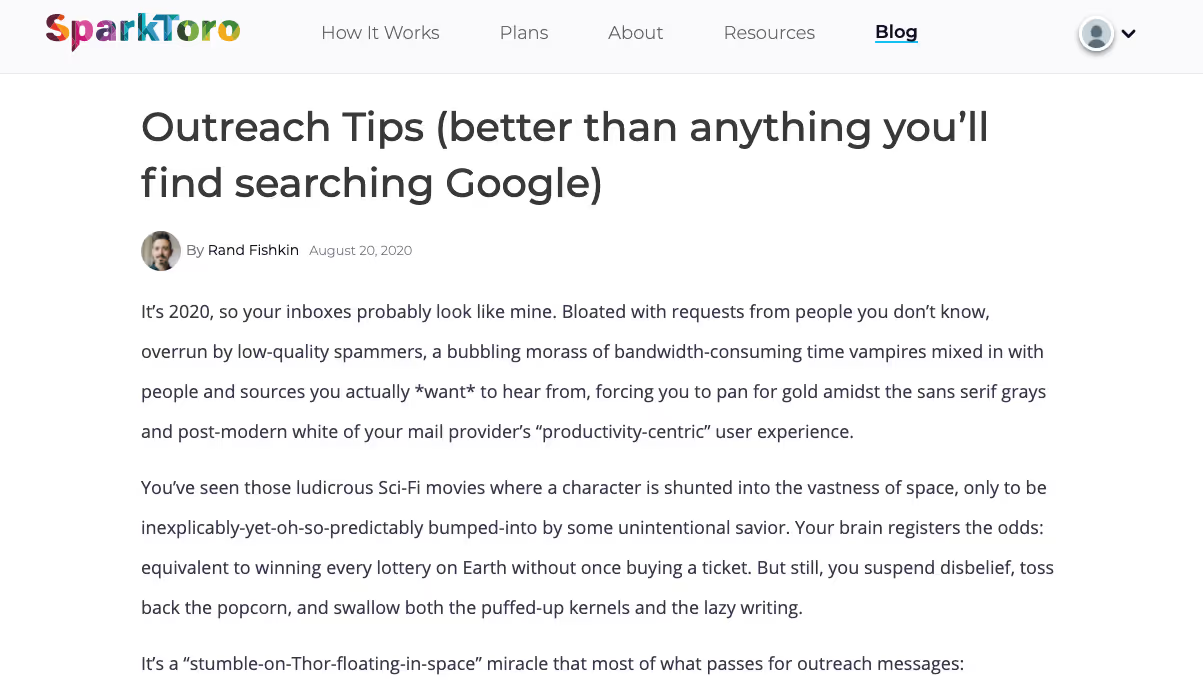
He took a slightly controversial approach, but it paid off. During our chat, we discovered that this article ranks at the top of page one for “outreach tips:”

Look at the results above. Which of these headlines stands out the most?
This might seem like a risky move, but there’s a method in the madness. We marketers have come to expect lackluster results when searching for broad keywords. As someone who personally sits within this target audience, I feel this frustration. Rand’s article stands out because it’s breaking the mold. The promise offered by the page title is more compelling than its counterparts.
So, how would we take a similar approach for a topic as dry as “VAT”? The rest of this guide will cover our framework for writing attention-grabbing page titles and meta descriptions. If you’re looking to increase organic CTR from the SERPs, read on.
Researching angles for killer page titles
Your page title is the first thing your audience will notice. So you’ve got to make it exceptional.
Reverse-engineering the SERPs is a good place to start, depending on how competitive your primary target keyword is.
For example, we’ve already identified several angles for our “what is vat” article:
- Defining what VAT is
- The fact it’s a guide
- How much VAT is
- The full definition “value-added tax”
“SERP-stacking” these themes to communicate a well-rounded, comprehensive article is one approach we can take. But for this topic, we’ll quickly blend-in – which is the opposite result of our goal.
So, let’s take the microphone to our audience. The best way to do this is literally getting them in front of a microphone, conducting customer interviews around their challenges and needs.
Another scaleable approach is searching for relevant keywords on Quora. This will provide us with audience sentiment, and uncover potential angles that competing content has failed to include. Here’s what we find for “what is vat”:
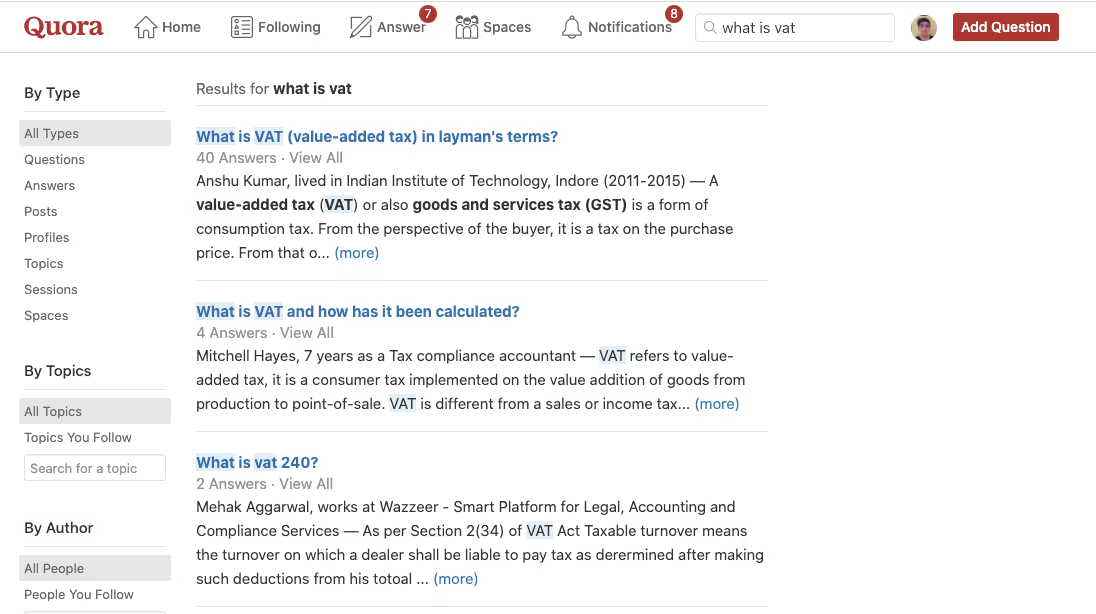
Immediately, I see a huge opportunity in the first result. Here, someone is asking for an explanation in “layman’s terms”. Nobody is making this promise in the SERPs.
Twitter is another great source of insight. But since nobody is tweeting about VAT in this context (and honestly, why would they?), I’ll use “sales pipeline” as an example instead:

I see two potential angles from this single tweet:
- Why You Should Build Sales Pipelines Before MVP
- How to Build Sales Pipeline & Close Your First Sale
If you’re writing for a startup audience, you’ve just coupled a topic (building sales pipeline) to the priorities and pain-points (before building your MVP and getting the first sale) of your audience. This insight will become tremendously useful in a moment.
Value-driven meta descriptions
I don’t know about you, but I rarely read meta descriptions.
I’m more of an “open-in-new-tab-and-judge-the-introduction” kinda guy.
Still, meta descriptions are important for communicating the value of your content to searchers.
This is your opportunity to show them your content will answer their most pressing questions. It’s also a chance to get them clicking on your content with anticipation.
We use a framework that takes one or all of these approaches:
- See what common themes arise on the SERPs
- Summarise what our content covers
- Look for questions people are asking elsewhere
Let’s take another look at the SERPs to build a more complete picture of searcher needs. For our “what is vat” article, these are the themes that keep coming up:
- “Current VAT rates – standard 20% and rates for reduced rate and zero-rated items…”
- “…is a tax applied to purchases of goods or services and other ‘taxable supplies…”
- “…broadly based consumption tax assessed on the value added to goods and services.”
- “For a business, VAT plays an important role and can be charged on a range of your goods and services.”
- “…it stands for value-added tax and it adds to the cost of nearly everything you buy in the UK.”
- “Value added tax, or VAT, is the tax you have to pay when you buy goods or services.“
Unlike page titles, there’s a tremendous amount of validation in these page descriptions. While a strong page title will stand out, our meta description should reaffirm they’ll find what they’re looking for.
In a way, Google has already done this for us. The elements are all here on page one. We just need to apply it to our own content.
The more a particular phrase or theme arises, the more we should be inclined to use it. Based on our findings, a possible meta description for our “what is vat” guide could be:
“VAT (currently at a rate of 20%), is value-added tax on purchases of products and services. Learn how to calculate it and what it means for your business in this complete guide.”
But as we’ve already discovered, there’s more to the story than the SERPs offer us…
Bringing it together & creating cohesive metadata
We have everything we need to craft attention-grabbing page titles and meta descriptions that communicates our content’s value.
Let’s start with our page title – which, from our research, is a no-brainer:
“What is VAT? A Layman’s Guide to Value-Added Tax”
Here, we’re demonstrating that we truly get our audience. We’re essentially saying:” “VAT can be complex, so we’re giving you content that’s easy to understand”.
We’re also communicating the fact it’s a guide, building context around the positioning of our content and setting expectations.
[[component]]
Next, let’s revisit our meta description. While it’s nice and comprehensive, this first draft comes in at 177 characters. As the recommended limit is 155 to 158 characters, we need to cut some of the fat.
After revisiting the SERPs (and putting ourselves back into our audience’s shoes), we’ve come up with the following:
“In this complete guide to VAT, you’ll learn how to calculate value-added tax and what it means for your business (current rate: 20%).”
This description communicates the following:
- Re-affirm the context (this result is a complete guide)
- You’ll learn how to calculate it
- Why it matters for your business
- The current rate
Including the current rate of VAT brings the answer to the SERPs itself. We’re providing utility in the SERPs for anyone who needs this information immediately.
Standing out, intelligently
You spend so much time producing and distributing your content. But metadata is part of the puzzle that often gets neglected.
Page titles and meta descriptions should make up a critical part of your content creation and promotion process. Without it, nobody will click-through, which means Google will likely decide your content is not relevant enough.
I know writers who craft ten or more headlines for their content. Take the same approach with your page titles and meta descriptions, and you’ll see your CTR soar.


This article breaks down how Headspace generates over 720,000 monthly organic visitors. You’ll learn how this ecosystem helped generate over 2 million paying subscribers for Headspace and how you can apply these lessons to a SaaS content marketing strategy.
The Headspace content strategy: delivering value through content ecosystems
The Headspace product is itself a content platform. It exists to guide people through basic meditation principles, inviting them to subscribe and take advantage of features to expand their meditation journey.
But you don’t need to be a paying customer to reap these benefits. Every piece of content is designed to deliver value and educate their audience regardless of membership or means..
The Headspace home page prioritizes this mission before presenting product features:
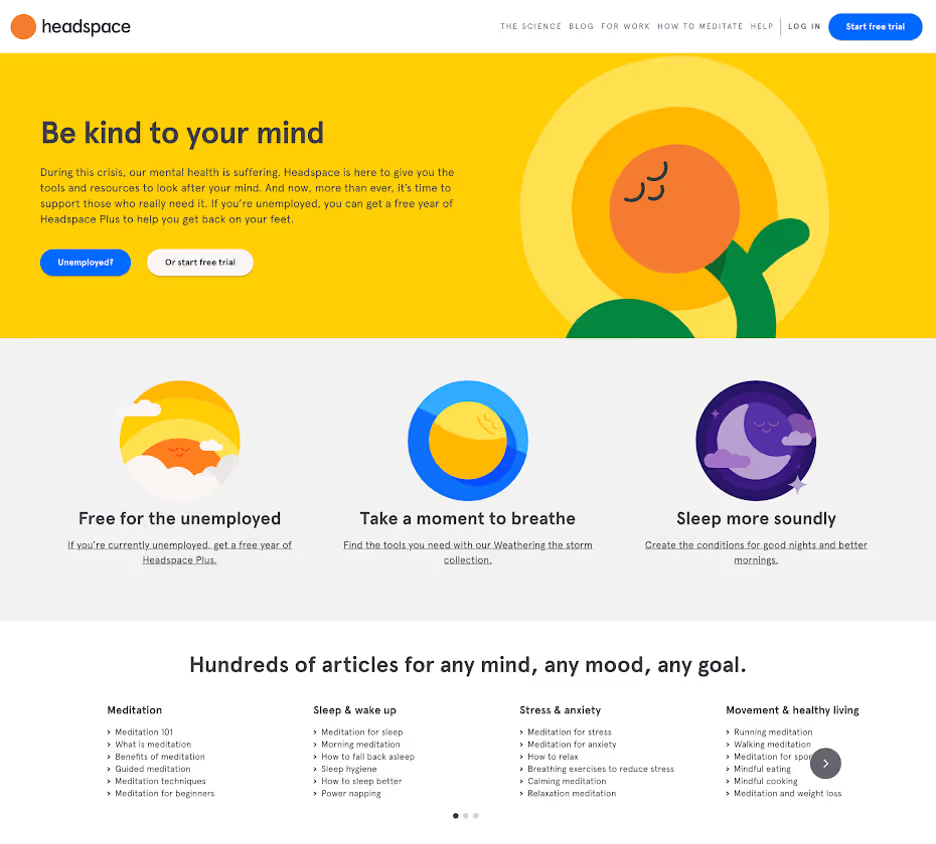
There’s a blend of urgent and evergreen content. If you’re new to the meditation scene, there’s plenty here for you to get started no matter your experience level.
Here’s what else Headspace does exceptionally well:
- A deep understanding of their customer personas—no matter where they are in their mindfulness journey
- Dedicated to over-delivering value on evergreen topics
- Rapid and agile responses to trends and major shifts in the world (e.g. when they offered free subscriptions to users affected by the COVID-19 pandemic)
- Cheerful and engaging branding that’s present throughout every blog article, video, and design asset
This strategy ensures their audience finds the information they need to start their meditation journey immediately.
This is what great content should do; inform, educate, and entertain in a way that builds awareness. Most importantly, it gets them invested in your product.
For SaaS and tech brands starting with content marketing for the first time (or those looking to improve their existing strategy), here are some lessons you can take from Headspace’s approach:
- Set the context: Why do you exist in the world? What are you hoping to help your customers achieve? This must be present in everything you create and publish.
- Conduct qualitative research: Data is critical for developing a content strategy. But you must talk with your customers to gain a true understanding of their needs. Ask them what they struggle with and what their goals are.
- Map needs to topics: Help customers solve these challenges by creating content on specific topics. Map your content to each pain-point. Identify trends that you can capitalize on.
- Go where your customers are: As part of those conversations, find where your customers are most active. Which channels, communities, social platforms, and publications have their attention?
- Build a community: Go one step further and become that channel. Create a space to let your audience come together, building a community around your product.
For example, martech brand Mutiny has created a community that brings senior marketers and revenue leaders together—both online and in-person:
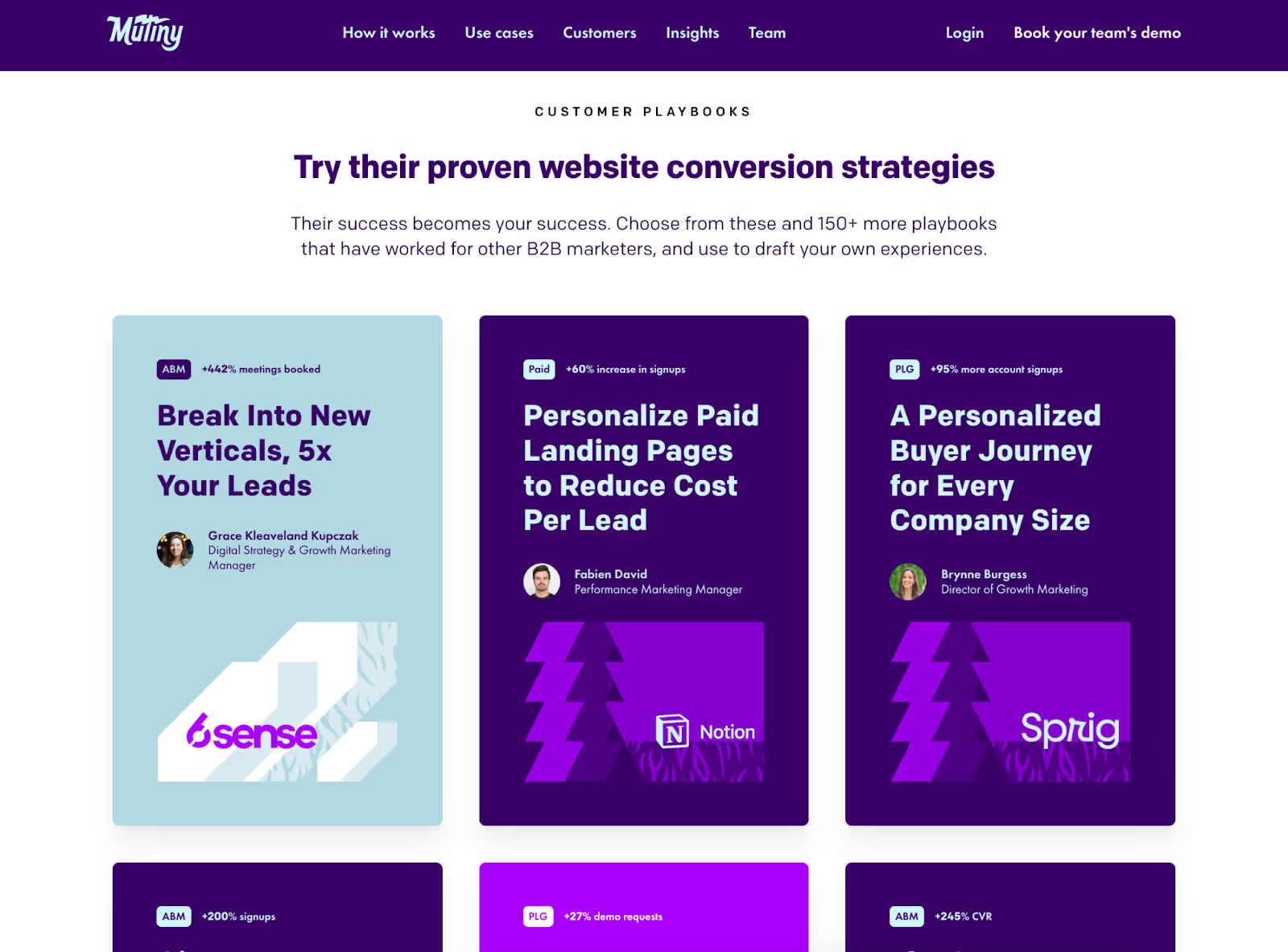
Not only does Mutiny’s community bring advocates and buyers together, but they also use it as a platform to share their stories. This philosophy transforms their customer into the hero, allowing the broader Mutiny audience to learn from their peers.
Your content strategy must serve your audience and align with your business objectives. Before publishing anything, ensure it accomplishes both of these outcomes.
Creating SEO-driven content in a competitive market
Headspace’s dedication to value-driven content helps them rank for highly competitive keywords like “meditation” and “mindfulness”:
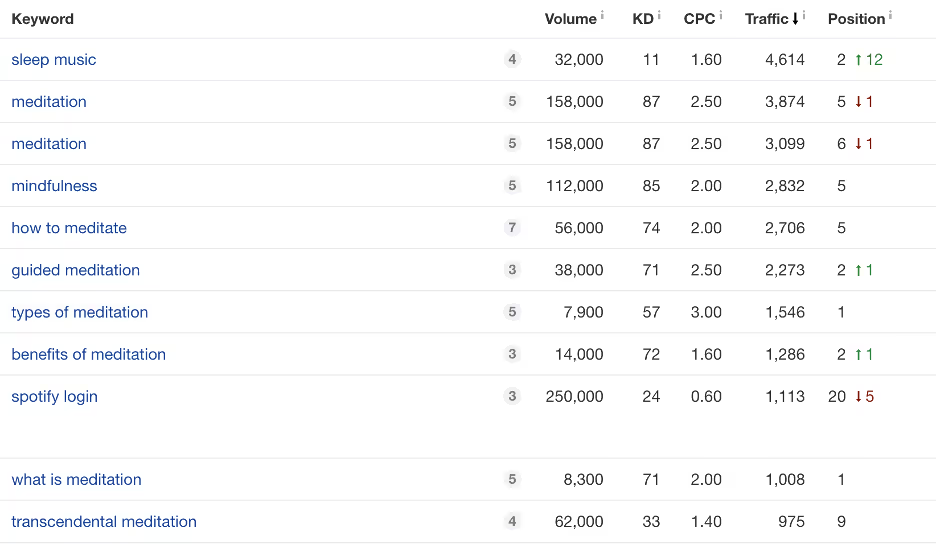
Collectively, the 143,000+ keywords they rank for generate over 720,000 visitors a month (according to data from Ahrefs).
To put that into perspective, you would need a monthly paid media budget of $619,000 to generate that traffic volume.
Let’s break their SEO-driven content strategy down further, starting with this content hub on “meditation basics:”
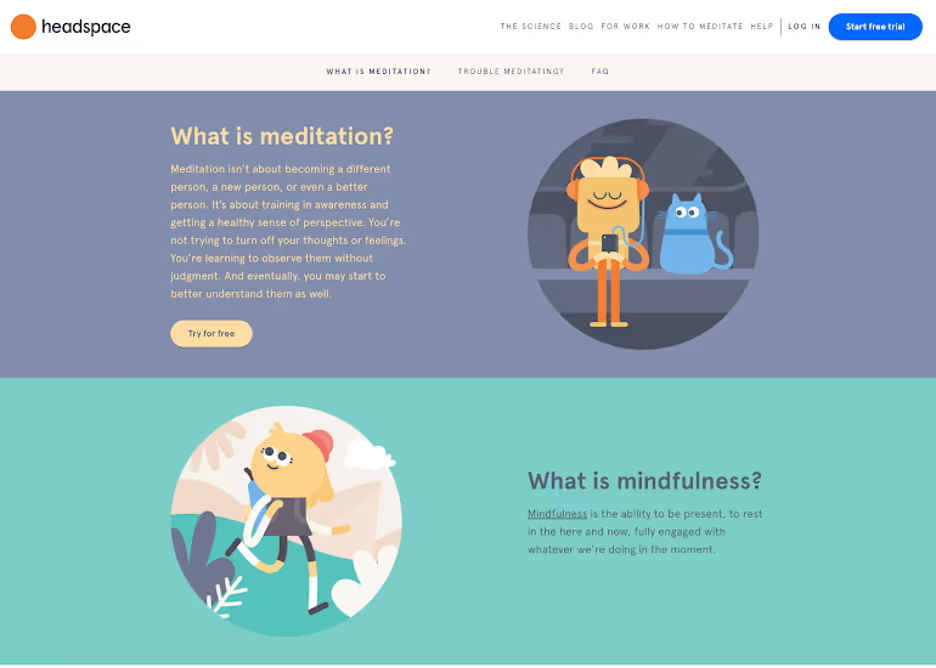
Using a hub-and-spoke approach, Headspace can create content around more specific topics, building out a comprehensive resource. This helps them build topical authority and rank for highly competitive keywords.
For example, this page currently ranks at position #9 in the SERPs for the term “transcendental meditation:”
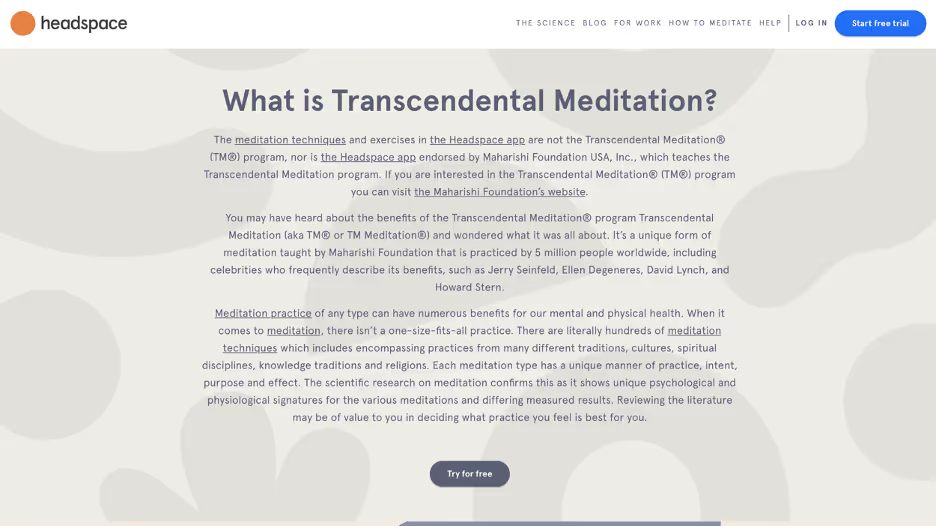
This article builds credibility and authority—both in the eyes of readers and the Google algorithm—by:
- Using objective data from third-party sources to back up claims
- Covering the basics of TM without overwhelming the reader
- Wrapping the content in a beautiful UI to keep readers engaged
The result is an incredibly engaging piece of content that organically attracts readers and backlinks.
Optimizing content for better results
A deeper analysis of Headspace’s blog presents several opportunities to improve results.
First and foremost, it could benefit from a more editorial-friendly format. In other words, remove the landing page style and reposition them as articles by expanding on each section.
Furthermore, according to Clearscope, there are several opportunities to include new themes that will help improve rankings:
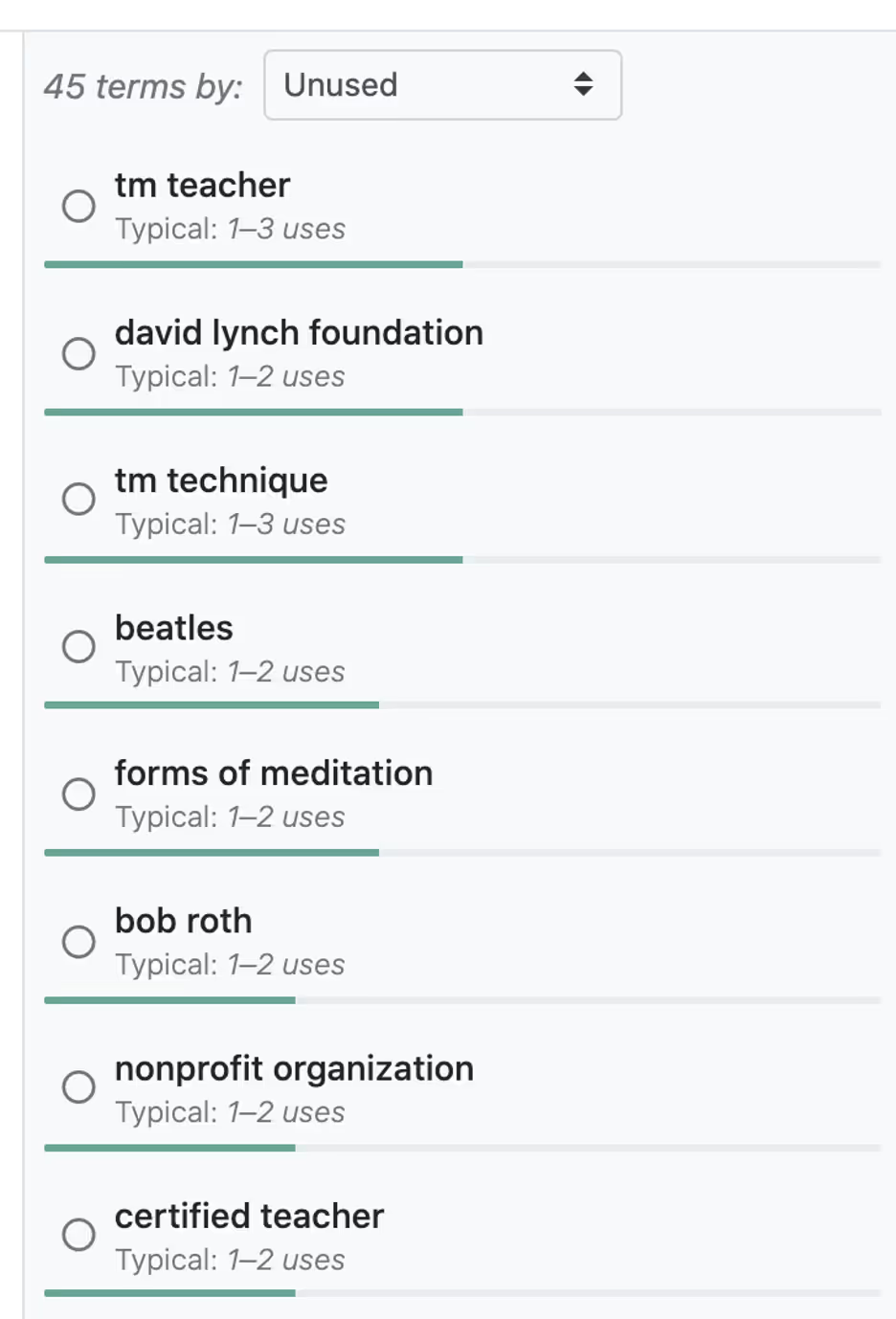
The same goes for their blog content. For example, this article ranks at position #17 for the term “high functioning depression,” which generates over 17,000 searches a month:
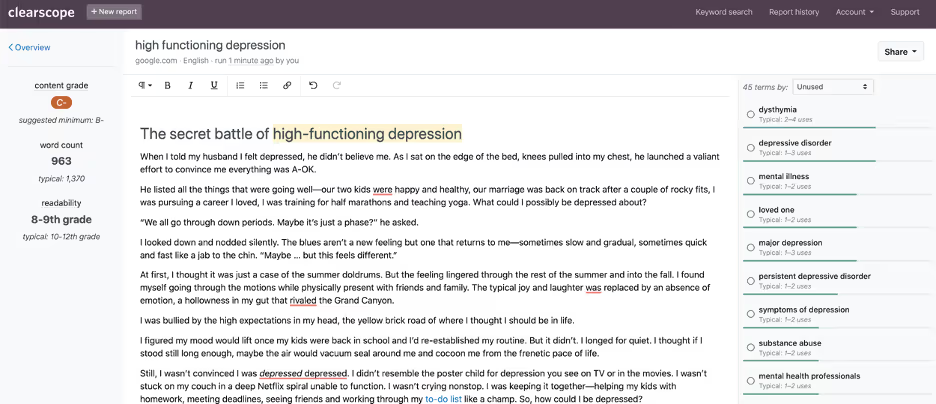
As you can see on the right-hand pane, there are several themes that the article could include to improve search performance.
I explore this in more depth in the video below:
Adopting a content optimization process can improve traffic and future-proof your content. It requires you to tend to your content like a garden. A publishing schedule and distribution act as soil and fertilizer, but you must water and prune those plants to see them flourish.
Charming and educational video content (generating over 120 million views)
Headspace's YouTube presence embodies the high-quality, educational content they're known for:"

Their presence on the world’s second-biggest search engine is impressive, with over 500 video uploads to date. According to Social Blade, Headspace’s YouTube channel generates an average of 658,543 views every day:

Their YouTube channel offers a cohesive experience that shares educational content around relevant topics.
Many SaaS and tech brands treat YouTube as a dumping ground for webinars, product demos, and sales enablement content.
This is a mistake. While you may attract views, you won’t build an engaged audience hungry for your next upload.
Thanks to their commitment to high-quality video content, Headspace has generated over 620,000 subscribers.
However, the question remains: how do they use YouTube as a standalone marketing platform? To answer this, let’s dig deeper into one of their most popular videos on understanding dark thoughts:
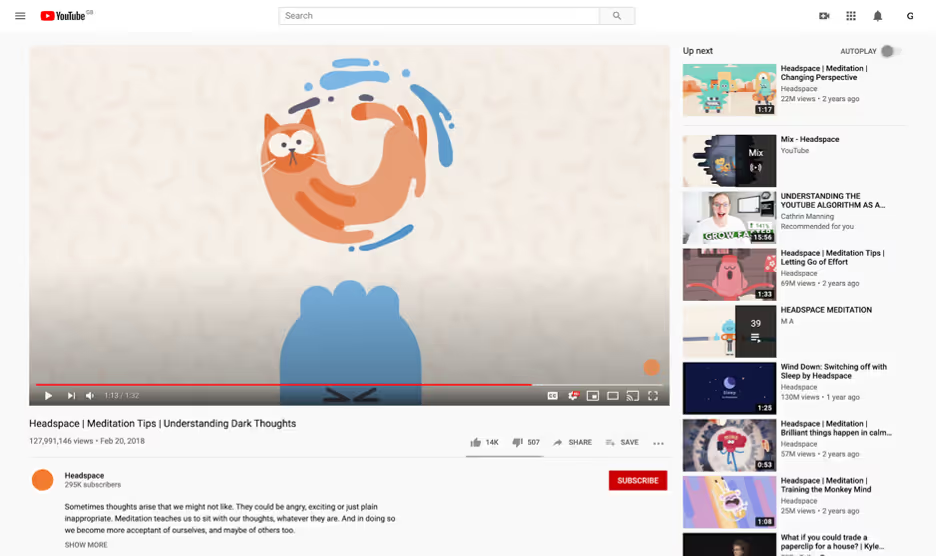
Based on the comments, we can deduce that paid media—namely pre-roll ads—has driven the majority of these 139 million views.
Despite this, it still garners a high level of engagement—with more than 14,000 likes and over 900 comments from people who find the disruption welcome.
We’ve discussed how content can fuel your paid media efforts in the past, and Headspace is proof that it works.
YouTube is also the second biggest search engine in the world, another factor that Headspace capitalizes on:
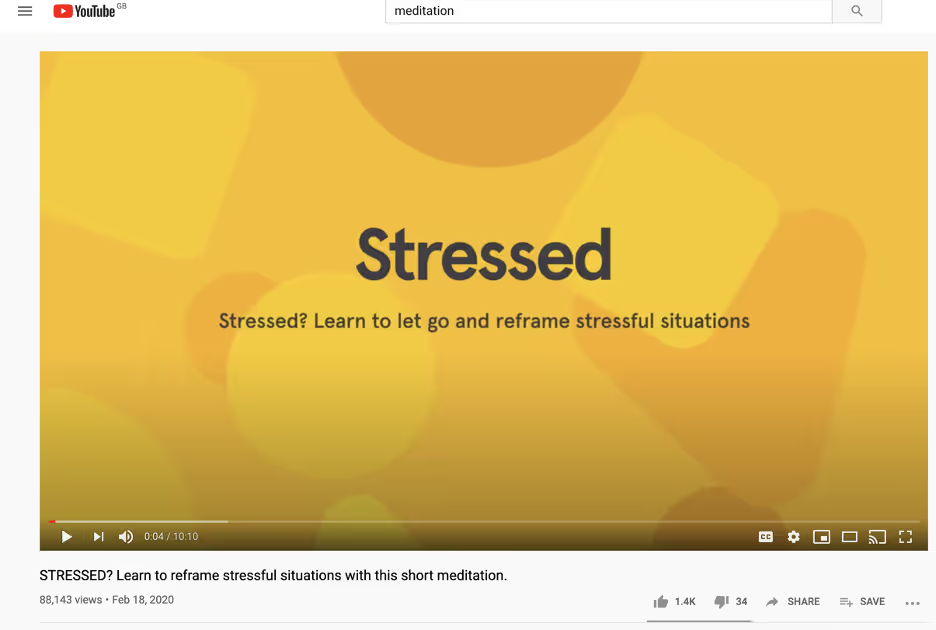
This particular video ranks for the term “meditation” and has generated over 80,000 organic views in four months.
In short, video is a critical component of Headspace’s organic and paid acquisition strategy. It generates clicks, educates their audience in entertaining ways, and drives new users.
Creating exceptional video content at scale
Producing high-quality video used to be a mammoth task. However, it’s not as expensive and time-consuming as it used to be.
By establishing visual styles and adopting proven video frameworks, producing video content at scale is now simple and affordable.
Headspace uses constraints to publish beautiful video content consistently. There’s a clear visual style, with each video focusing on a specific purpose:
- Short guides: Beautifully animated videos that provide advice on specific topics
- Interviews: Long-form videos where Headspace’s founder, Andy Puddicombe, interviews experts and thought leaders
- Direct-to-camera: A scripted format where Andy sits in front of the camera to provide meditation advice
They’ve also created several “limited video series” around specific topics. One example is “Sleepcast,” an audio series providing free bedtime meditations:

Applying constraint to your video marketing allows you to scale up production while maintaining a high bar for quality. Commit to specific frameworks and batch elements of the production process to maximize resources.
For example, if you’re looking to publish four direct-to-camera videos a month, batch the live-action portion across one or two days.
Use your social media presence to set audience expectations, create a cohesive experience for viewers, and get them excited for future videos.
Digital PR, link building, and getting featured by Bill Gates
Headspace have gained their fair share of press attention. With mentions from CNBC, Forbes, and even Scientific American, they’ve effectively climbed the attention ladder.
Done right, digital PR contributes to brand awareness and helps you connect with prominent industry influencers.
Headspace’s digital PR activity took on a life of its own when they caught the attention of Bill Gates. In his own words, the product helped him go from meditation skeptic to believer:
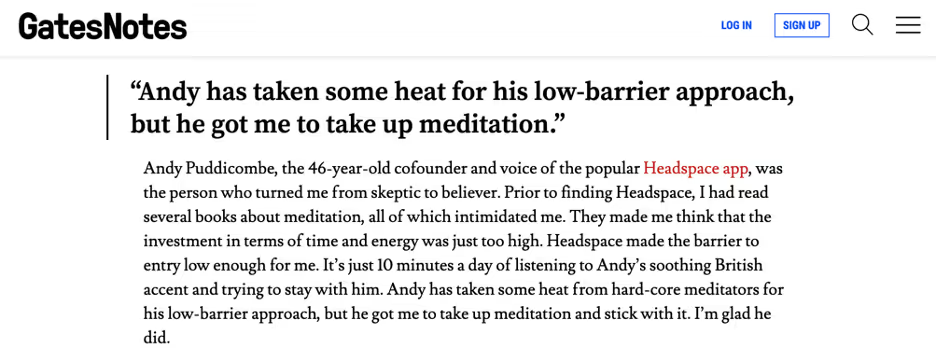
Headspace consistently get picked up by publications for several reasons:
- They create exceptional content in a variety of formats: This includes blog and video content, as well as “traditional formats” such as books. Package and position your content in new ways to open up distribution opportunities.
- They simplify complex ideas: The science behind meditation can be daunting. Andy and the team have broken this into digestible chunks, seen throughout their entire content ecosystem.
- They produce owned data: Journalists are hungry for new studies and data to cite. It helps them back up their content, make accurate claims, and increase their stories' credibility. Create data-driven content, become a go-to resource, and generate backlinks in the process.
Headspace goes one step further, partnering with scientists and organizations to conduct their research. Not only does this amplify their reach, but it makes these studies more credible:

This approach can help fuel your link building efforts. Do this by creating assets that allow creators and brands to enhance their content. Experiment by creating content around highly shareable formats:
- Thought leadership: Expand on a topic and deliver delightful experiences. Make your content so comprehensive that others can’t help but link to it.
- Studies and research: Use owned data to conduct research and report on trends. Survey your audience about their experiences or thoughts on specific topics.
- Infographics & visual content: Content creators are hungry for illustrations, graphs, and infographics to include in their content. This helps them make their content more valuable and engaging.
Social media scheduling tool Buffer took a data-driven approach to digital PR with their “State of Social” report:

Over 100 blogs and publications cited this report in its first 14 days of publication. At the time of writing, it now has over 1,280 referring domains.
Developing strong relationships is a critical ingredient for digital PR. Cold outreach has its place, but establishing partnerships and collaborating with other brands is more effective in the long term.
Why? Because editors, bloggers, and journalists get bombarded with generic pitches every day. Instead, find ways to collaborate and help everyone win.
For example, we recently helped a martech client get featured in several publications and blogs by creating content with other marketers. Using this approach, we achieved a 37% response rate and a 44% link acquisition rate.
It’s not just about links. These conversations will lead to other business opportunities that ultimately help you capture a wider audience.
Building a personal brand around Andy Puddicombe’s expertise
Founders often start their business around a problem they have first-hand expertise in. It’s essential to get that expertise out into the world.
To date, Headspace Founder, Andy Puddicome, has talked at leading conferences like TED, SXSW, and The Ellen Show:
His story is compelling and easy to connect with. The journey that led him to create Headspace is full of valuable lessons we can use when adopting a meditation practice.
No matter the size of your company—or your role within it—you can share your voice and story to build connections and bridge the gap between brand and customer. This works best for:
- Founders and CEOs: Become the face of your company. Connect with influencers and connectors in your space. Those relationships will last a lifetime when the time comes to step away from the spotlight.
- Marketers: Same goes for growth, demand generation, and content leaders. You can make your job easier by becoming the face attached to every blog post, guest post, or video. You’ll achieve results for your company while advancing your career in the process.
For example, May Habib, Co-founder and CEO at Writer, uses LinkedIn to share content around generative AI and product updates happening at Writer:
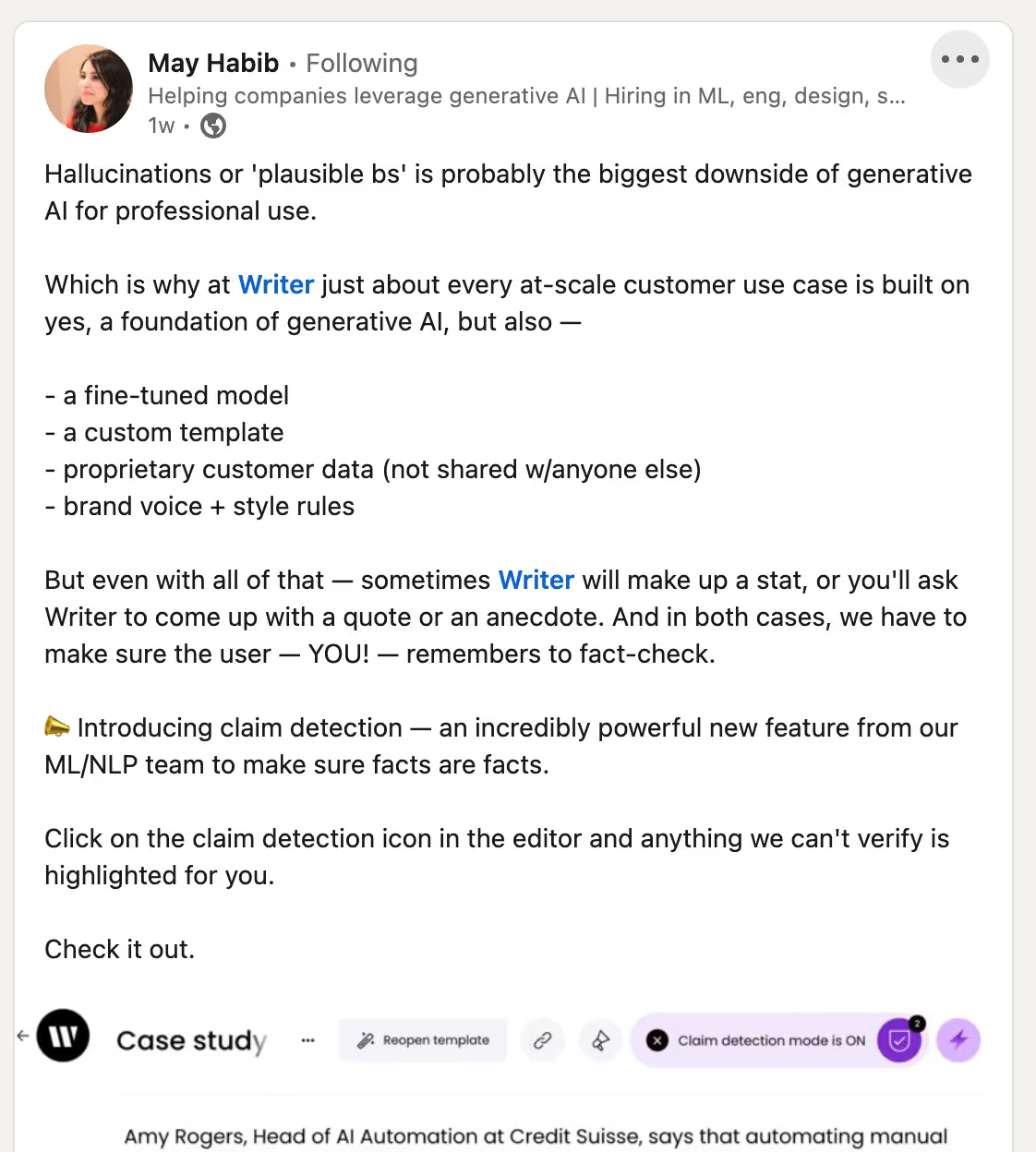
People connect with other people. Building a personal brand and human presence is important for both startups and enterprise companies alike.
Converting readers and viewers into paid subscriptions
No matter where you look, Headspace offers one clear call-to-action:
“Download the app.”
This kind of CTA can often be a huge ask when selling complex or high-ticket offerings. For product-led SaaS or tech brands like Headspace, it makes absolute sense.
Let’s look at what the customer journey from “awareness” to “subscription” may look like for a single user to understand why:
- They browse YouTube and get suggested a video from Headspace teaching a specific meditation technique
- They watch the video and decide to read more about the concept on the Headspace blog
- They follow a link to another article and decide to download the app and follow the free 10-day meditation program
The Headspace content ecosystem contributes directly to user acquisition. From here, they can deliver more value in the app with free lessons, using relevant CTAs and offers to convert free users into paid ones—the classic freemium model.
In this sense, the Headspace product is part of this content ecosystem. It makes sense to drive app downloads from blog posts, YouTube videos, and other owned content assets.
For SaaS and tech brands, the offers and CTAs you use across your content will depend on the complexity of your product, solution, and the nature of your sales process.
You might offer a newsletter CTA to build an audience and slowly nurture them into leads. Or, you could offer a free trial or demo of your product. This is especially effective when crafting crafting bottom of funnel content.
Headspace can nurture free users with three methods:
- Email marketing (newsletters, announcements)
- Mobile push notifications (retention)
- Product marketing (adding new free content)
For example, the email below invites free users to dive back into the app if they’ve not tried a meditation after a specific period of time:
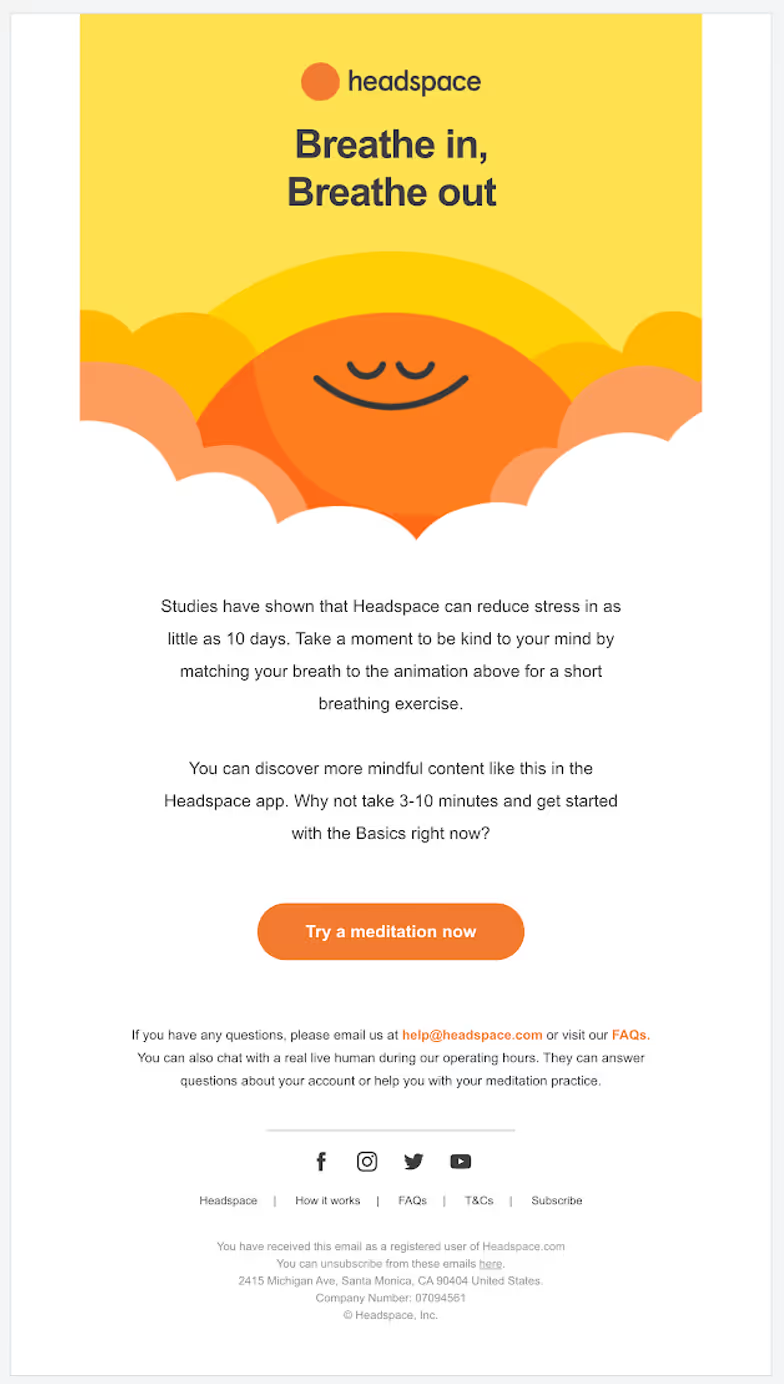
The CTA encourages the user to learn the basics, easing them in by addressing a time-based objection: it takes three to 10 minutes.
Users are far more likely to continue their journey and invest in a monthly subscription if they consume free content within the app.
Build a content ecosystem
Any B2B or SaaS brand can learn something from Headspace.
They’ve built their content strategy on the premise of delighting, educating, and empowering their audience at every touch-point. It’s no wonder they’ve created a product loved by millions of users.
Great content marketing establishes a strong foundation for trust to emerge—all while contributing to critical growth goals needed for success.
Start with your existing customers. Discover why they value your product and put more of that into the world. Do this across your selected channels, and you’ll quickly build a brand your audience loves.


In this article, we go beyond content marketing basics and cover the principles behind content that generates a high average time on page, builds emotional resonance, and drives conversions. I also share before and after examples of edited content and show how small changes can make a big impact.
1. Create emotion-driven content to plant persuasive seeds
Your content is an asset that will help you achieve a goal, like increased conversions, more website traffic, or credibility that lands you in the consideration set.
But what job-to-be-done (JTBD) does it fulfill? How can you strategically motivate, empower, and influence the decision-making process—even in long sales cycles?
If your messaging doesn’t align with readers’ JTBD, it won’t resonate. Attempting to connect with or persuade readers solely with logic and data discounts the emotional motivators behind buying decisions.
Emotional motivators are future-based desires. They range from wanting to grow confidence to feeling a sense of belonging to building a successful business..
Consumers feel most aligned with their favorite brands when they experience trustworthiness (83%), integrity (79%), and honesty (77%). But even when a brand is trusted, it often still fails to speak to its customers’ emotional drivers.
This missed opportunity costs money. Fully connected customers are 52% more valuable:
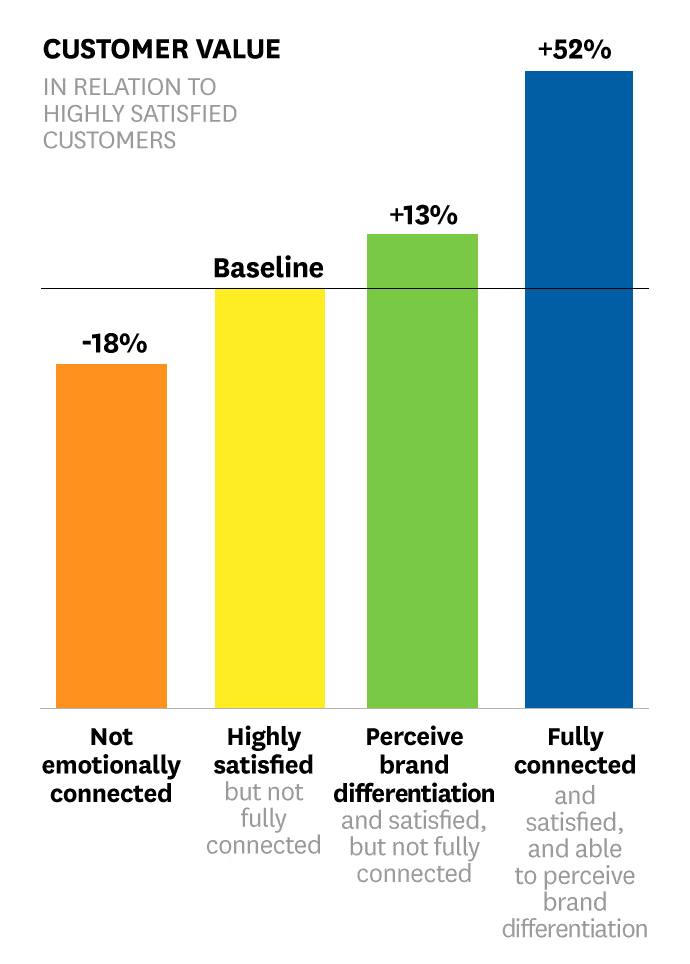
Emotional drivers vary based on your brand, category, customers, customer segments, and stage of the buying cycle. Conduct research (surveys, phone calls, data-driven insights) to uncover the key motivators that drive your audience, then execute emotion-driven content.
Here are a few ways to do that:
Inject storytelling into your narrative
It helps to think of your content as a conversation between yourself (the narrator) and your audience (the reader).
The bridge is storytelling, which is all too often left out of a data-driven narrative:
“Content that relies only on data to tell your story can end up falling flat. Worse, it can overtake the heart of the matter—creating stories that align with your strategy and speak on behalf of your brand.”
To get to the heart of the matter, return to your emotional motivator research to answer:
- What keeps your audience up at night?
- What do they dream about doing/achieving?
- What makes them trust information and what makes them wary?
- What kind of content do they find compelling, and why?
- What’s their primary JTBD and what emotional driver is that tied to?
As you build your story, continuously confront your readers' pain points or desires. This will create a personalized experience that helps them understand, connect with, and trust your solutions.
For example, Patagonia’s audience is primarily driven by the desire to feel a sense of belonging and to protect the environment. The team behind the outdoor brand knows how critical it is, therefore, to make their audience feel like they belong.
I wrote about how they do this in an article on storytelling for the CXL blog:
“Their Climbing Stories, for example, showcase anecdotal experiences, often told in the first person. They’re full of tips and tricks, practical methodologies, and recommendations. Stories from the mountains, as told by Patagonia’s customers themselves.
Emotionally, they make the reader feel like they’re part of something bigger. Practically, they inspire new and improved purchases to solve a challenge (e.g. how to pack for alpine climbing).”
Patagonia cleverly builds trust and resonance by creating a space where their customers can tell stories to each other.
Lavender, an AI email assistant software, also masterfully uses storytelling to connect with its audience. At time of writing, they’ve grown to 26,000+ followers on LinkedIn by posting humorous videos that are universally relatable.
Their target audience is sales reps, who’s biggest pain point (and barrier to success) is getting their emails ignored.
Watch how they address this common struggle, and position Lavender as the hero, in this short yet brilliant video:
If you’re already a fan of Lavender, this makes you smile because you’ve experienced a massive uptick in email opens like Kyle Coleman:
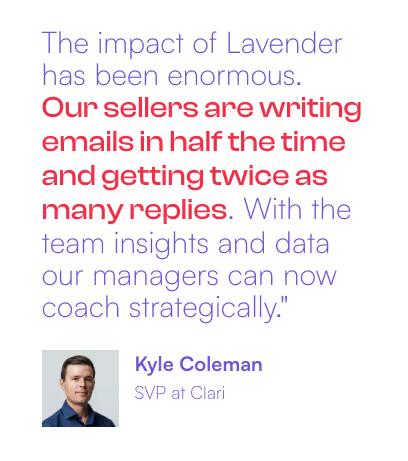
If you’re a potential customer, this makes you curious and eager to see if what they’re boasting holds truth.
Storytelling, whether owned or leveraged, is only one way to plant persuasive seeds. Let’s look at another.
Spike emotional resonance with creativity
When everyone sounds like each other, people are drawn to innovative ideas. Creativity is a strong way to differentiate and create memorable content that stays top of mind.
Done right, it entices audiences to think in new ways, consider new concepts, and overcome skepticism. When you offer value in a way that no one else does, it builds trust, which is paramount in gaining a competitive advantage.
However, if you recall, trust alone won’t move the needle. You need to use creativity to speak to those high-impact motivators that drive purchases.
One way to do that is to bring experts into the conversation. Sounds simple, but many content marketers still rely solely on third-party data to drive first-person narratives.
SMEs can help you find unique angles, make contrarian points, or speak to why established norms work so well.
They’re also personalization powerhouses. Hearing how a like-minded expert approaches a problem, overcomes a boundary, or achieves a desired outcome makes it easier to picture doing the same thing in your own life. It humanizes the topic—in turn, humanizing the brand.
For example, Semrush has a customer segment that’s driven by a desire to succeed at work and in their personal lives. To speak to those drivers, they need to make their customers feel that by using their product, they can lead more meaningful lives.
They did just that in a newsletter that shared SME insights through an emotive storytelling lens. Told through the eyes of SME Gaby: SEO by day, DJ by night:

Gaby lives life on her own terms—an image that evokes freedom and worth. Through Semrush, Gaby can redefine her work-life balance and experience the best of both worlds.
While Gaby doesn’t share any expert tips per se, her position (SEO specialist at Peacock) and lifestyle (thriving DJ and aspiring producer) is creatively positioned to add credibility to the conversation.
It’s a masterclass in spiking emotional resonance. Anybody with a desire to live life on their own terms will feel inspired to check out how Semrush can aid their journey.
2. Drive your points home with relatable examples
Want to kill emotional resonance before it has a chance to work its way into the subconscious and influence decisions?
Brands devote countless hours to strategy and research, only to miserably underperform on execution. They’re proud that they’ve come up with a solid roadmap, but refuse to spend the necessary time building editorial standards that will allow them to produce high-quality content at scale.
One of the biggest differences between mediocre and valuable content is the ability to overcome the generalization gap:
Too many content marketers make a point and then leave the reader hanging. Where's the takeaway, example, or actionable advice?
Yes, content needs to be skimmable . Even if your reader is lazy or in a rush, you shouldn’t be.
Explain the “why” behind the “what” to remove guesswork and add value
Never miss a chance to explain your point further. That could leave the reader guessing and motivate them to find the "why" somewhere else.
For example, if you write a sentence like, “X is especially true because of Y”, you need to explain why Y matters.
Take this before and after as a case in point.
Before: “It's clear that the user experience Podia facilitates is valuable, particularly in a mid-pandemic world."
Ok, but why?
After: “It's clear that the user experience Podia facilitates is valuable, particularly in a mid-pandemic world where people have extra time, a desire to learn something new, and an unparalleled impulse to connect with others."
Most people can relate to feeling isolated and yearning to connect during a pandemic. Now, you’ve not only explained why, but you’ve connected with your audience on that crucial emotional level.
This adds a human element to your content. It’s what helps you go beyond the role of a robotic business trying to sell something to make a profit. It shows that you understand because you feel it too.
Nobody wants to feel like they're being sold to. Everybody wants to feel seen and heard.
Similar to how sales superstars master the art of connecting with their prospects on a personal level, use specificity to drive authentic connections.
Show, don’t tell to prove authenticity
These days, “take my word for it” doesn't fly. Not when social proof and word of mouth influence buying behavior, purchasing decisions, and brand loyalty above all.
A Deloitte study finds that, in order to bring authenticity into the digital age, you need to lead with purpose and center the human experience:
“Purpose answers an all-important question, ‘Why does a company exist?’—and the answer can serve as the beacon for all organizational decision-making.”
To prove authenticity, make sure to demonstrate exactly how you accomplish your goals. If you have permission, inject social proof by centering a real customer story that personalizes your data.
For example, Co-Founder and Co-CEO Alina Vandenberghe understood the power of a strong brand before she started Chili Piper. Its brand has managed to differentiate amongst steep competition like Salesforce.
Peep Laja of CXL writes:
“I've been watching the meteoric rise of Chili Piper. So many lessons to be learned from this company.
Their net revenue retention is super high (which also landed them an amazing valuation during their series B, like a 20x multiplier on ARR).”
Alina Vandenberghe wrote an article on how they built the brand from the inside out. She doesn’t simply talk about the journey, she gives specific examples of how they skyrocketed brand awareness and audience building:
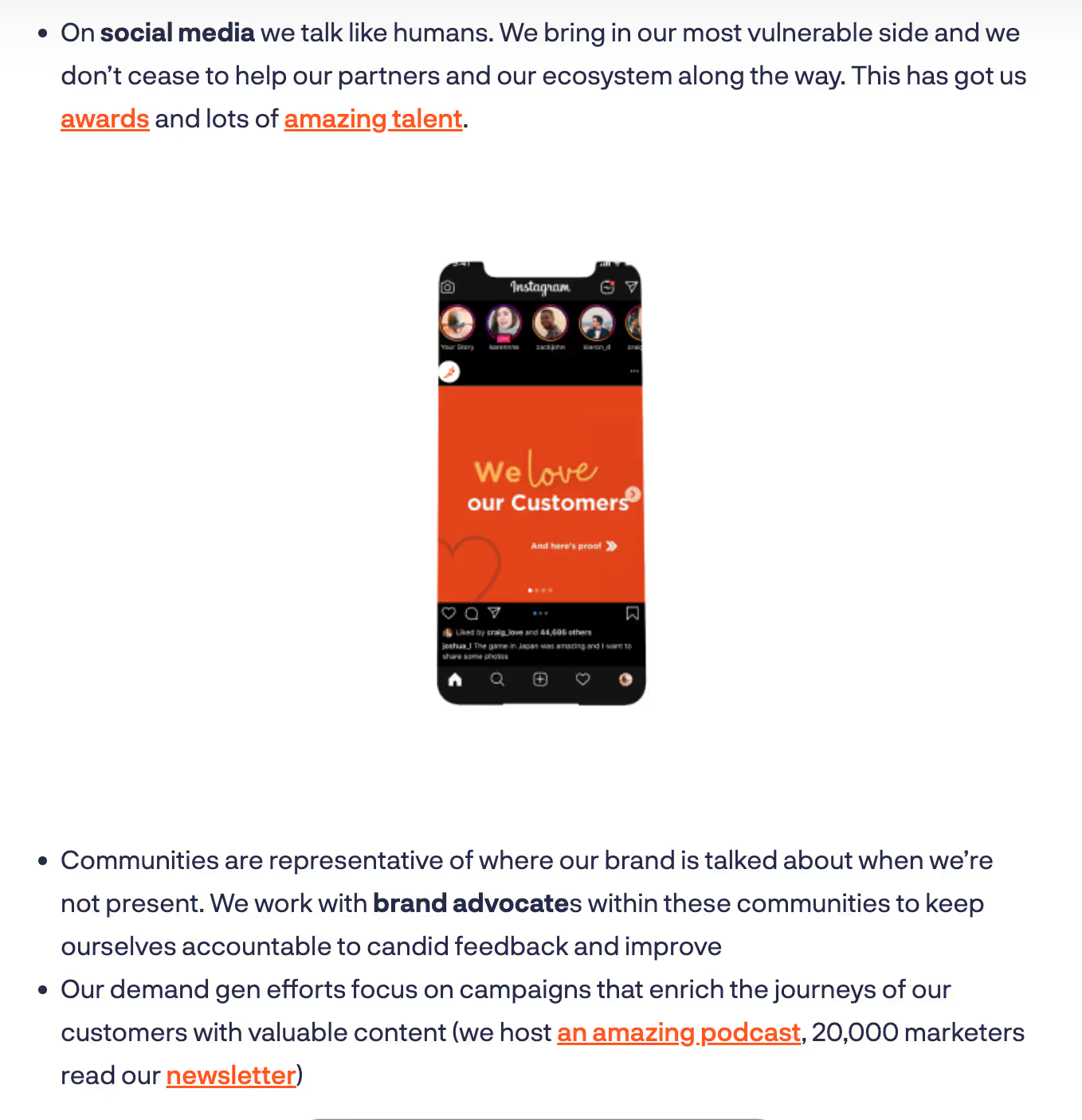
Authentic content often correlates with transparency. When you give away your ‘secrets’ for free, people feel more connected to your purpose and want to come along for the ride.
3. Declutter your copy and avoid redundancy
This may seem basic, but even advanced content writers struggle with wordiness and redundancy.
We all have publishing deadlines breathing down our necks. But if you’re starting to feel like you’re prioritizing quantity over quality, catch yourself.
Figure out why your sentences are averaging 20+ words and set up a strategy to reset and refocus.
Create a process for self-accountability to stay on track
At Grizzle, our writers create a detailed outline before getting started to make sure they avoid waffle. A comprehensive outline acts as a roadmap to follow, which reduces the chance you’ll repeat key points (which adds friction to the reading experience).
But if you’re a short-outline, write-as-you-research kind of creator, catch yourself at the end. Take a few hours away from your draft and revisit it before you publish.
Your message needs to be simple, clear, interesting, and skimmable. Complexity and wordiness do you no favors and certainly don’t give you an intellectual upper hand.
Content marketing isn’t intended to mimic dissertation’s, argumentative essays, workflow documentation, or anything else that calls for longer prose.
To declutter your copy, focus on these key copywriting principles:
Use active not passive voice to empower your reader to take action
Active voice is easier to skim and empowers the reader to take action.
Why? Because we're putting the power in their hands.
Rather than telling the reader that something can happen to them, we want them to feel like they can take charge and make it happen for themselves.
This ideally leads to the reader clicking a CTA or internal link, which works to build a stronger connection and gets them closer to becoming a customer.
For example:
Passive voice: “If you don’t have a mathematics degree, gaining professional qualifications like these is likely to boost your career prospects.
Active voice: “If you don’t have a mathematics degree, pursue relevant professional qualifications to boost your career prospects."
The language is more actionable and likely to inspire and energize the reader.
Another example:
Passive voice: “To optimize the time of your sales team, utilizing a data-driven marketing automation approach is key.”
Active voice: “To optimize your sales team’s time, utilize a data-driven marketing automation approach.”
It’s cleaner, easier to read, and tells the target audience (in this case, sales managers) exactly what to do (i.e. learn from data and automate repeatable tasks).
Rather than a solution that reads like half-baked advice, active voice empowers the reader to take matters into their own hands.
Trim the fat to get to the point
Never use more words than you need to. To quote William Strunk Jr., co-author of “The Elements of Style”:
“Omit needless words! Omit needless words! Omit needless words!”
People skim, but when they do land on a section of interest, they need to be engaged.
If your sentences twist and turn and are full of words that don’t really need to be there just to further make a point that you feel is important then you’ll lose them in a heartbeat.
See what I did there?
Let’s try that again. If your sentences are redundant and wordy, your readers will leave.
Here are a few examples of how to trim the fat:
Before: “To start making a plan, sit down and ask yourself the following questions:”
After: “To formulate a plan, ask:”
Before: “Affiliate marketing is often paid out by getting a free product or service.”
After: “Affiliate marketing is often paid via product or service payouts.”
Before: “To get more likes on Twitter than you’re currently getting; to squeeze everything you can out of a post, you need to approach content tactically."
After: “To get more likes on Twitter, approach content tactically.”
Your reader gets the same point, faster. Cutting superfluous words is not about cutting value. Quite the opposite. It creates more value because it’s easier to understand.
Avoid redundancy to preempt boredom and cultivate your character
I think of redundancy in two buckets:
- Repeated words or phrases that are overused and thus redundant
- Repeated ideas that are unnecessary because you’ve already made your point
Avoid both types.
Here’s an example of redundant words:
Before: “The roles begin to diverge once you take technical skills into account. Sales engineers have technical skills that allow them to identify patterns that someone without technical expertise may miss.”
See how the phrase technical expertise is starting to sound like a tongue twister?
After: “The roles begin to diverge once you take technical skills into account. Sales engineers have the industry expertise to identify patterns that an untrained eye may miss.”
That’s a lot easier to get through.
Let’s look at one more example.
Before: “When working with potential customers, technical sales engineers can explain complex concepts in a customer-friendly way. They use their knowledge to explain to potential clients how the product works and what makes it unique.”
After: “When working with prospects and leads, technical sales engineers can explain complex concepts in a customer-friendly way. These experts can demonstrate exactly how your solution will produce desired results and what makes it unique.”
Variety makes copy more compelling. Nobody wants to read the same word over and over. At best, it will make your copy look sloppy. At worst, it will look like keyword stuffing, which is the fastest way to appear robotic instead of a relatable, human narrator.
Redundant ideas are harder to neatly demonstrate as they often pop up throughout content rather than in the same sentence or paragraph.
For example purposes, I’ve condensed redundant ideas into one paragraph:
Before: “When pitching to investors, use data to dial up the pain and show how trends in digital adoption could harm business if they don’t act fast. As an example, [company name] outlined the opportunity investing in digital transformation presents. They hit stakeholders with some pain, and then showed them how they can turn it into an opportunity.”
After: “When pitching to investors, use data to dial up the pain and show how trends in digital adoption could harm business if they don’t act fast. Then, use examples to outline the opportunity on the other side of these pain points. As an example, [company name] used qualitative and quantitative data to demonstrate risk and showcase outcomes.”
The difference is nuanced but important. The first is slightly repetitive, and the second makes the same point without any repetition.
In the first example, the writer makes a point that you should ‘dial up the pain’ then ‘outline the opportunity’ this pain presents. They wrap up the paragraph with the same exact point, stated differently. It’s still effective, but ever so slightly repetitive, which we don’t want.
The second example wraps the ‘use pain to then outline opportunities’ point into the entire paragraph. Thus, they make the same point, but in a uniquely different way. It flows smoother and fit better into a seamless storytelling narrative.
It’s impossible not to repeat your ideas throughout a piece of content writing, but in doing so, make sure they flow seamlessly and aren’t obvious repetitions of one another.
This way, by the time your reader gets to the end, you’ve driven your point home so smoothly that they fully understand your argument but don’t feel exhausted or bored by repetition.
Key takeaways
Content marketers that master emotional resonance thrive. Content marketers that create strategies built to spike emotional resonance, then execute them with a quality-first mindset win.
Devote equal time to strategy and execution to build a competitive advantage and an army of loyal fans.


In this article, you’ll uncover a compelling argument for taking more creative risks, the importance of expanding your frame of reference, and learn specific methods to build a competitive moat around your content and brand.
Why creativity is more important than ever in an AI-generated world
The late futurist Jacques Fresco once said:
"Creativity takes known elements and puts them together in different ways.”
Jacques’ work was famous for its creativity. He consistently challenged the status quo in city design, resource management, and social engineering. This reimagination of how to use modern technology was born out of frustration at the lack of industrial innovation.
Today, your audience feels that same frustration due to how common bad content has become.
Blog articles have rapidly lost their zest and originality. As marketers compete for the same keywords, they rely on identical frameworks as their competitors.
But buyers can see that most SEO-driven articles are unreliable and copy each other, which undermines their trust in Google as a source of information.
What’s worse, tools built on top of OpenAI and ChatGPT are exacerbating the problem. While this will ultimately make our jobs as marketers and creators easier, in the present reality they’re being misused to create terrible experiences.
Consumers are already calling out media brands who churn out low-quality content. Just take this comment from a recent Unilad post:

How do we alleviate doubt and delight readers? How do we offer an experience that surprises them and builds trust?
Injecting creativity and doing what robots can’t is the only way.
Use creativity and benevolence to build a content moat
Creativity elevates your content and builds trust with skeptical readers.
As Jacques Fresco said, this requires putting “known elements” together in unique ways.
But we still need to generate business results. Content that generates the lion’s share of attention does so for a reason: it fulfills search intent.
The problem is, everyone ends up copying each other. Trust is eroded as your customers bounce from one article to another.
Creative applications to SEO-driven content helps your content stand out. It keeps the reader on the page, sending engagement signals to Google. The longer a user sticks around, the more likely they are to take action.
Let’s say you’re writing an article on relationship selling. Typical advice for this topic includes “giving value” and “solving objections.”
However, based on your experience, you know it’s important to build intimacy by counter-intuitively challenging prospects and introduce them to their peers.
This perspective offers a unique approach to relationship selling into your article. It builds trust with your readers and creates a stack of value.
Why go through so much trouble for a single piece of content? Because it’s the only way you’ll break through your audience’s “B.S. shield” created by copycat and low-effort AI content.
In their “How People Read Online” report, Nielsen Norman Group found that there are two components to building trust in content:
- Credibility: The user believes you have the ability to provide the information they’re looking for.
- Benevolence: The user believes you have good intentions for providing that information.
One participant of the study shared their experience reading an article from Cleveland Clinic about the health benefits of kombucha. However, despite reading the entire thing, they decided to find a second opinion:
“[The Cleveland Clinic article] was very pro-kombucha. Which is why I was like, I’m going to look somewhere else.”
They ended up reading a Healthline article that shared both the positive and negative effects of kombucha. Healthline offered a complete and impartial perspective. In turn, the reader learned to trust Healthline on the topic over Cleveland Clinic.
Benevolence is an often overlooked element of establishing trust, which is impossible to do if you’re only emulating other articles in Google or relying solely on what AI tools give you.
Broaden your inputs to uncover new creative ideas
Creativity isn’t an ephemeral characteristic. Remember, creativity is simply the act of “putting known elements together in different ways.”
New creative endeavors, therefore, require us to do two things:
- Collect new inputs (such as content, conversations, and data from new places)
- Expand your frame of reference (by investing in new experiences or experimenting)
As a B2B content marketer, a practical way to broaden your inputs might involve researching what other industries are doing to promote their products.
For example, if you’re charged with growing enterprise software, you might find unique content formats in the ecommerce world.
But there’s so much more to it than this. To drive these principles home, let’s explore three specific methods for collecting new inputs to elevate your content.
1. Pay attention to how journalists tell stories
A good hook will communicate why readers should care about your message and earn their attention to continue reading.
Take this example of an introduction found in a blog post on digital transformation:
Digital transformation is a global business phenomenon, capturing the attention of enterprises in every industry and spurring major investment.
Learn why digital transformation matters now, what successful initiatives look like, and how to avoid common pitfalls.
It’s unlikely this introduction makes you feel emotionally invested to continue, even if you’re eager to learn about digital transformation.
Let’s compare this with an introduction from The Atlantic, taken from an article titled “Coffee really does make you happier:”
“I remember the night I fell in love.
“The year was 1977, and I was 12 years old. A neighbor kid’s parents had bought an espresso machine—an exotic gadget in those days, even in Seattle. There was just one Starbucks in the world back then, and as luck had it, we lived within walking distance. The neighbor kid and I bought a pound of coffee and had about eight espressos each. Feeling fully alive and inspired to get closer to the universe, I climbed onto the roof of his house. In the process, I cut a gash in my stomach on his gutter. Bleeding profusely, I marveled at how intense the stars were.”
Not only is an emotional connection made, the story is relevant. The headlike makes a promise before the click, and the introduction sets the reader up to go on a journey that’s likely to have a satisfying payoff.
Using relevant stories will hook readers in and keep them engaged throughout your entire article. When relevant, they can quickly communicate what’s possible with your advice and help your audience relate to your experiences (or those shared by third-party contributors, subject matter experts, etc.)
If you get abstract with this approach, make sure to get to the point quickly. For example, when I shared the story about Jacques Fresco, you may have wondered how it was relevant.
While it hopefully piqued your interest, I didn’t expect to keep your attention for long. So, I made the story succinct and quickly tied it back to the underlying point I wanted to make.
You can use this journalism-inspired technique to create a pattern interrupt. Done right, stories can offer a welcome respite in industries known for dry or technical language.
Here are some methods for finding a worthy subject for your journalism-inspired stories:
- Historical figures and industry legends: Share the lessons learned by those who paved a new way of doing things. Lay the foundations for your argument by blending timeless stories with current issues.
- Underdogs: Avoid leaning on unrelatable lessons from brands like Apple and Coca Cola. There are plenty of small businesses and startups that have achieved a more relatable definition of success. Few can emulate the actions of a billion-dollar brand, but most can apply the principles that helped a business generate its first $100,000.
- Behemoth backstories: If you must use a Fortune 500 brand to make a point, go back to its roots. Marketing blogs love talking about Apple’s branding, but nobody talks about Steve Jobs’ time as a video game designer and his Buddhist pilgrimage to India.
- Individual contributors: Celebrate how practitioners achieved a specific goal. For example, by breaking down the nuances of Apple’s product photography to provide relatable takeaways.
Finally, don’t neglect your own experiences. You have a tremendous amount of wisdom to share.
2. Find an investigative angle with complementary or conflicting data
Many content marketers and writers have a habit of using stats to back up ideas they’ve already committed to.
But it only works if that data is statistically significant, presented honestly, and adds value to the reader.
The best writers use data to share additional perspectives while offering the most suitable conclusion for the reader.
Take this piece on mushroom intelligence from Psyche:
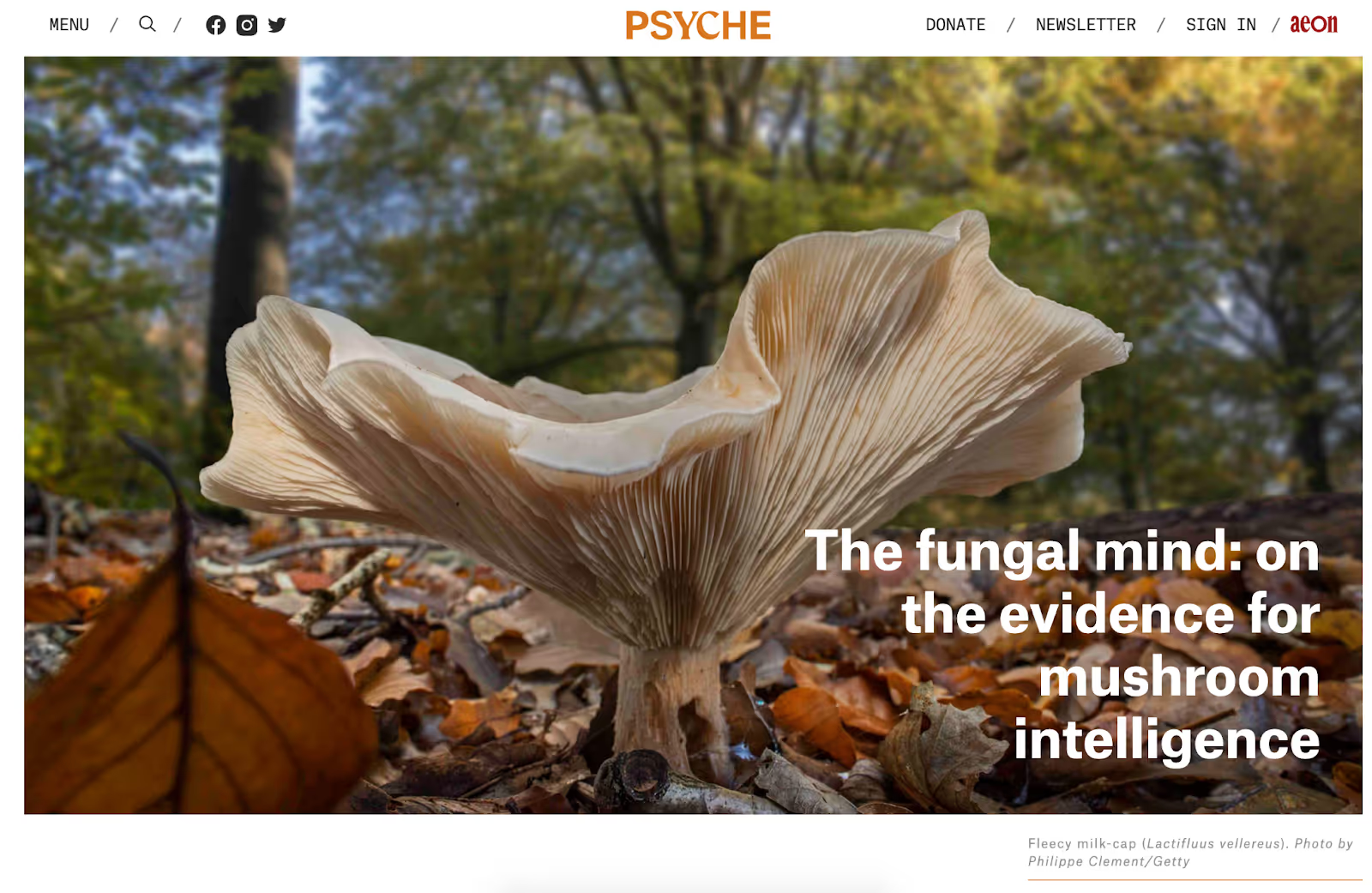
The entire article is a science-backed exploration into the behavior profile of mushrooms.
Here’s how the writer talks about an experiment involving beechwood:
When researchers followed the transfer of nutrients in the lab, further remarkable discoveries were in store. In a tray of soil, hyphae were observed to make contact with a block of beechwood. [...] The fungus in these experiments showed spatial recognition, memory and intelligence. It’s a conscious organism.
They then use data taken from several studies to to interpret how different mushrooms behave:
The behavioural complexity of fungi increases when they interact with living trees and shrubs rather than dead wood. Some of these relationships are destructive while others are mutually supportive. Pathogenic fungi can be very cunning in how they feed on plants and evade their defences.
The author provides an in-depth analysis of fungi, generating over 10,000 shares on social media— a tremendous amount of engagement for a story about mushrooms.
Taking an investigative approach to data-driven content can provide unique angles for your content.
For example, our article on the backlink profile of Buffer and other SaaS brands took a very different direction to the one we originally intended.
The investigative journey that fueled this article looked liked this:
- Use seed data: We started our investigation with this Semrush study, which found that “only 22% of respondents are creating original studies and data-driven content” and “24% say they rely on external publications (digital PR) or guest blogging” for distribution.
- Check your assumptions: Many SEO studies have found that links do matter when growing search traffic. If this is true, why is nobody creating data-driven content, which has been proven to generate links?
- Ask a better question: Do how-to articles, definitive guides, and other SEO-driven content formats still generate links? From our experience, link building outreach that relies on these formats is ineffective.
- Apply your first investigative layer: To answer these questions, we identified data-driven content from 10 well-known SaaS brands and collected backlink data from Ahrefs.
- Add a second investigative layer: We found that these data-driven articles generated an average of 847 backlinks. However, this still didn’t answer whether or not they get more backlinks than editorial and SEO-driven content.
- Add a third investigative layer: We dug deeper into Buffer’s most linked-to pieces of content to find an anecdotal answer.
- Identify the conclusion: Not only does Buffer’s “State of Social” report stand out in terms of backlinks, but we found it was 293% faster to generate the first 100 links to this report than their most linked-to blog article.
Imagine if we stopped at the Semrush study. This article would have looked like every other piece on data-driven content.
Curiosity is the only thing you need to uncover engaging narratives, and access to the data that fuels them is often democratic.
Allow yourself to be proven wrong. If you find two sources that contradict each other, dig deeper into both.
Are there differences in sample size or representation of survey respondents? Use these methodologies to your advantage. Share your findings to tell a story that helps your customers solve their problems.
We talk all about how to use stats honestly and with integrity in this episode of the Demandist podcast.
3. Establish an expert committee to poke holes in the status quo
Subject matter experts (SMEs) can inject your content with credibility.
If the content on page one of Google looks similar, they’re likely exacerbating the same falsehoods.
SME insights can help you break the cycle of false information by calling out what conventional advice gets wrong.
This can build trust with your audience—especially if you debunk an unspoken yet well-known falsehood.
Going back to our article on relationship selling, we found that most blog posts oppose the idea of being likable.
However, our internal SMEs with decades of experience selling to the c-suite inherently disagree. And they can prove it.
Not only will this angle make your content stand out, it will undermine the falsehoods your competitors amplify, giving your audience more reason to trust you.
Jakub Rudnik, Head of Content at Scribe, uses this approach to make his content more original:
As a trained journalist, I look for opportunities to bring in experts wherever possible. Who is the best-case source? What other sources can offer different perspectives? This may not be completely original, but so few content marketers are willing to take these steps.
Get SMEs invested in your content by making it worth their time:
- Batch conversations into topical themes: Schedule one call a month to discuss a single theme or series of articles.
- Communicate asynchronously: Allows SMEs to share their expertise in their own time with Slack voice messages.
- Fuel their personal brand: Many SMEs aim to elevate their message to build awareness. Offer to repurpose your blog content into a LinkedIn post or Twitter thread for SMEs to share with their audience. Better yet, get it featured in a guest post.
SME insights will also help you build E-E-A-T. Featuring the voice of known experts sends a signal to Google that your content is credible, establishing you as an authority in your topic cluster of choice.
Inputs shape your outputs
Creativity is suppressed if we drink from the same altar. Outputs become homogenous and we end up creating the same thing as everyone else.
To inject your content marketing with creativity, collect new inputs and broaden your horizon with new content formats.
Build a moat by doing what nobody else is willing to build. Watch as it provokes thought, influences the conversation, and builds trust with even the most skeptical audience.


Your content brief is the roadmap that paves the way for high-quality content.
Without a solid brief, you’re likely to produce content that fails to meet expectations. A good brief connects your strategy and traffic goals with expertise and audience needs.
After collaborating with dozens of clients, content marketers, and writers, we’ve found the best approach to removing production headaches is a strong angle, detailed outline, and collaboration at the brief stage.
Your audience, why this topic matters to them, and how you’ll inject your expertise should be crystal clear for every stakeholder.
This article will detail the process and components of a content brief that drives high performing blog posts, landing pages, and more.
Content positioning
Content marketing is suffering from a case of “blind leading the blind.” For SEO-driven content, research often starts and ends by reverse engineering the SERPs.
Reverse engineering Google is critical for search. However, it will hurt your credibility if used as your only research method. Copying other articles “because they rank” is symptomatic of a lack of subject matter expertise. Your buyers can smell it a mile off.
Solid research is the bedrock of a great content brief. Conducting SME interviews, taking inventory of your own experiences, and diving into the rabbit hole of a topic is critical when writing for skeptical and experienced audiences.
But let’s assume you’ve acquired this expertise and done your research. It’s time to create a content brief, but where to start?
There are two key steps that must be followed when beginning the content brief creation process:
- Analyzing the competition to see what they’re doing right, what they get wrong, and gaps they’re leaving open.
- Establishing a unique angle that will ensure your content stands out—no matter which channel you prioritize it for.
These two elements are the most effective ingredients to establish a strong position in the market. One will give you the data to make creative decisions, while the other will help you stand out.
This is what we call “content positioning.”
Content positioning means treating your content like a product, differentiating it in a competitive marketplace, and helping your ICP solve their jobs-to-be-done (JTBD).
How to find an angle that outperforms the competition
Content positioning requires an understanding of the value other articles are offering and how they’re currently getting attention.
To identify competitive gaps, you must first understand what you’re up against. There are three approaches to competitive content analysis:
- Content quality: What’s the overall quality of other articles? Do they lack value? Are they repeating the same conventionally held (yet incorrect) beliefs as everyone else? It’s often possible to outcompete on quality alone or by focusing on a hub-and-spoke strategy to build topical authority.
- Brand equity: Are you up against a number of industry incumbents? Do they have a monopoly on the topic, or are they dipping their toes in? This is a reality that should inform your overall content strategy, not just your brief. For example, a project management brand like Asana writing a one-off article on “remote working” is unlikely to have much authority on the topic.
- Distribution landscape: For SEO-driven content, how hard would it be to rank based on the number of backlinks other articles have earned? What’s the keyword difficulty for your primary term (as well as the average across your entire keyword cluster)?
Your findings will inform how you approach the production and distribution of your content. For example, you may find a top competing article from a startup has lots of backlinks, but is poorly written and contains little utility. This is a prime opportunity to outcompete by creating more authoritative and value-driven content.
Competitive analysis will help you inform your content positioning and create original blog articles. Here are three practical ways to apply your findings:
1. Finding unique angles for search
Too many content marketers continue to create content by reverse-engineering and emulating the SERPs. But this presents a deeper issue, as content begins to look the same and, over time, erodes the user experience.
While aligning content with search intent is critical for organic growth, it mustn't be followed blindly. Use the SERPs to evaluate competing content and identify gaps that you can fill.
For example, when writing an article on CRM technology, you might find that nobody covers how to evaluate and choose the right platform. Instead, everyone focuses on definitions, benefits, features, and the like.
In this scenario, you could include an entire section that teaches readers a process for evaluating CRM vendors. This creates a temporary moat around your content and provides the reader with more value in the form of practical next steps in their vendor research.
2. Communicating credibility and authority
Marketers often make lofty claims with no data or proof to back them up. This provides you with an opportunity to build a more credible and original piece of content.
Building authority is more than writing in the language of your audience. It means collecting or leveraging experience and expertise on a topic.
For example, if you’re writing for a senior marketing audience on ICP research, you’d ideally seek input from an expert that has experience conducting countless customer interviews.
Using your audience’s language will generate more engagement. But to build trust, don't just emulate their words, speak their mind. Reflect back what they're thinking but nobody else is saying out loud. This will build deeper emotional resonance and connections. These insights can only be gleaned from someone your reader would consider a peer.
3. Be controversial
In marketing, zigging while everyone is zagging can be all you need to differentiate yourself.
Rand Fishkin, founder of SparkToro, did this when a customer asked for advice on cold outreach. After searching Google, he found the SERPs contained repetitive and outdated advice:
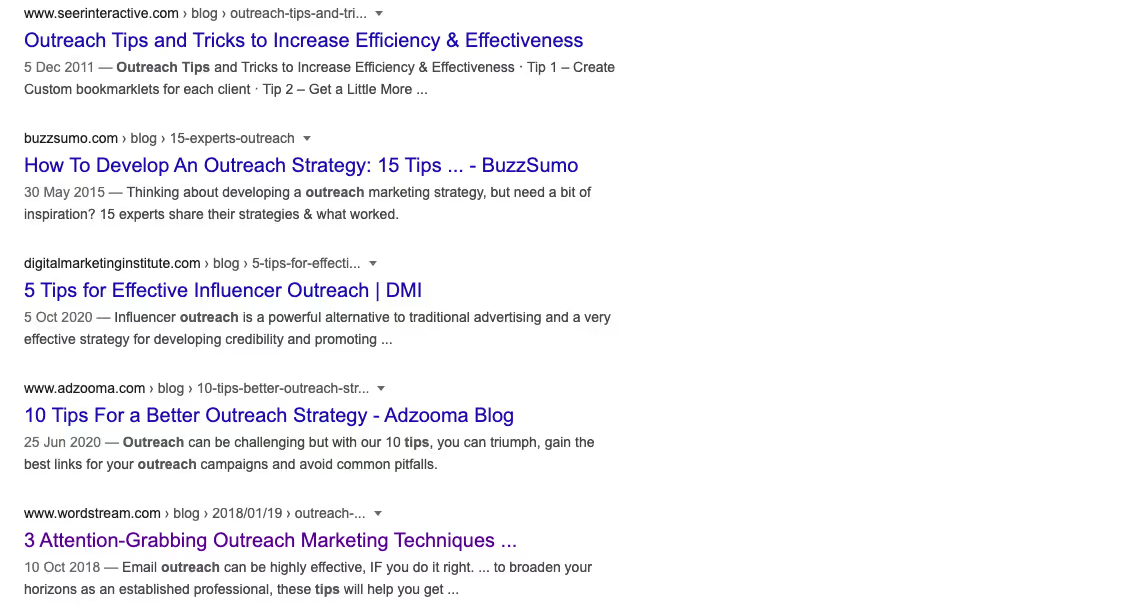
So he decided to write an article on the topic to call out these outdated practices, titled “Outreach Tips (better than anything you’ll find searching Google):”
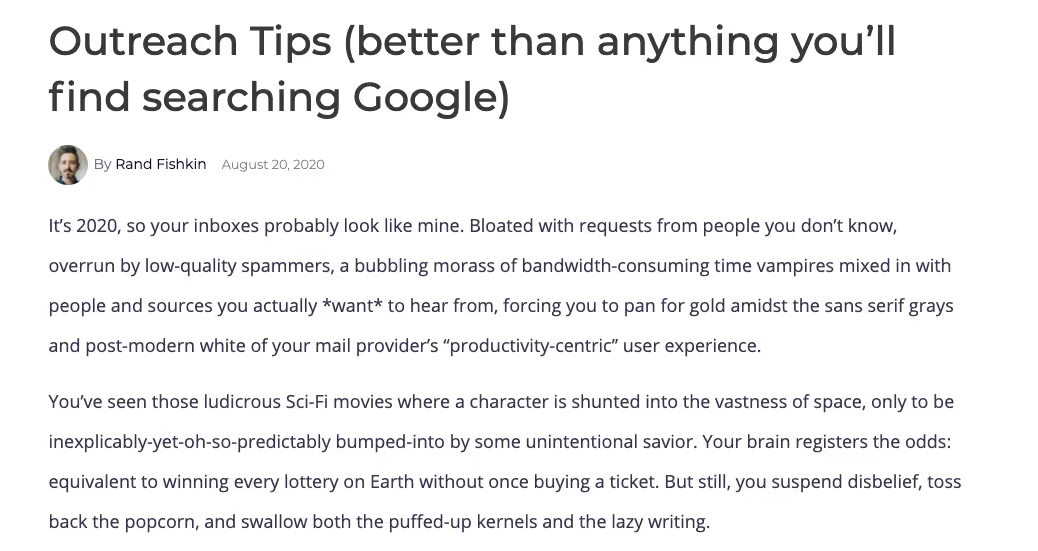
He opens up with a controversial introduction before moving on to a subsection that promises the reader eight tips they won’t find anywhere else.
This article is one of the most commented on the SparkToro blog and ranks below the featured snippet for the term “outreach tips:”
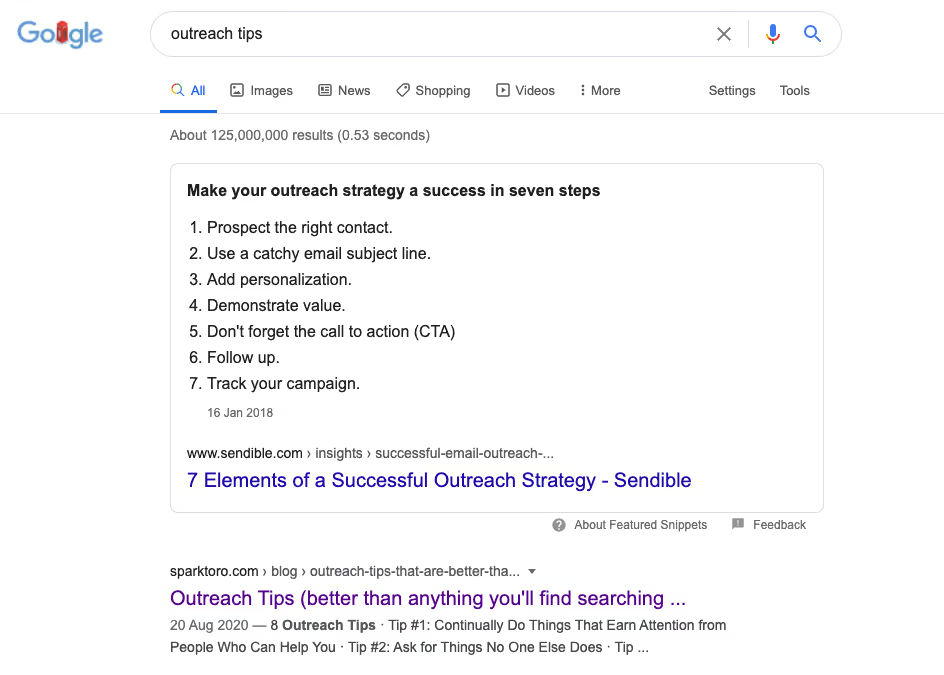
[[component]]
When a seasoned marketer or salesperson next searches for cold outreach tips, which result do you think will stand out in the SERPs? We’d hazard a guess that Rand’s article gets the lion's share of clicks.
A controversial angle breaks the mold and grabs attention in a sea of sameness. Allow your content to stand out by framing it around earned, accurate, and proven advice.
Building an outline using data & creativity
A good outline creates context around your content and communicates the narrative to other stakeholders involved in the production process.
Including a clear objective will keep everyone aligned on outcomes and avoid the problem of “too many cooks in the kitchen.”
Let’s say you’re a SaaS startup and your primary goal is “generating organic traffic with high buying intent.” In this scenario, your article should sit within the sweet-spot of these three areas:
- Algorithm: What themes, questions, and sections has Google deemed important for the user to fulfill search intent?
- Audience: What are your customers hungry for and what gaps are competitors leaving unfulfilled?
- Product: How will your content align with your value proposition, solution, or product?
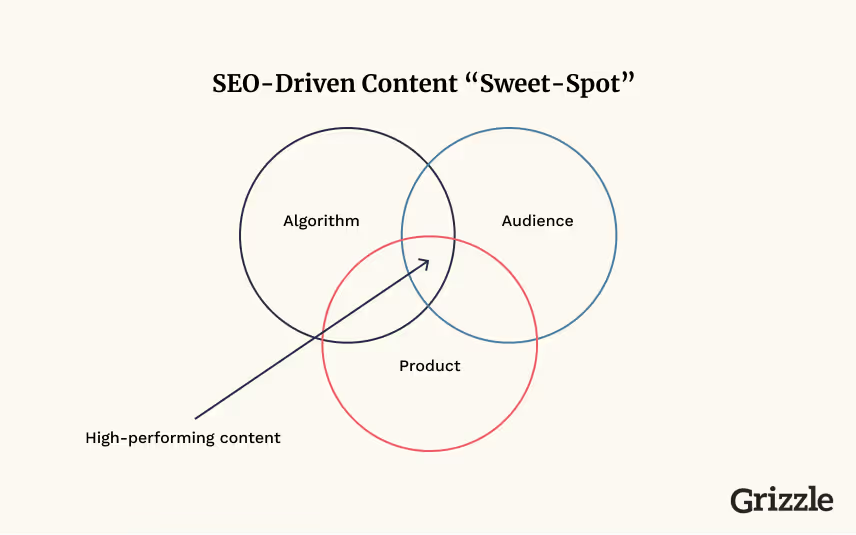
Templates and frameworks can guide you through the production process and reduce the friction in getting started.
For example, a “how-to guide” template follows a step-by-step instructional narrative, which is perfect for anyone targeting individual contributors looking to solve a problem or JTBD.
Alternatively, when targeting senior decision makers, you might use a framework that outlines their problem, builds an argument for new solutions, and demonstrates a new way of doing things.
Use tools like Clearscope when planning SEO-driven content to uncover which themes to include. Here’s what some of those relevant terms look like for the term “DOOH” (digital out-of-home media):
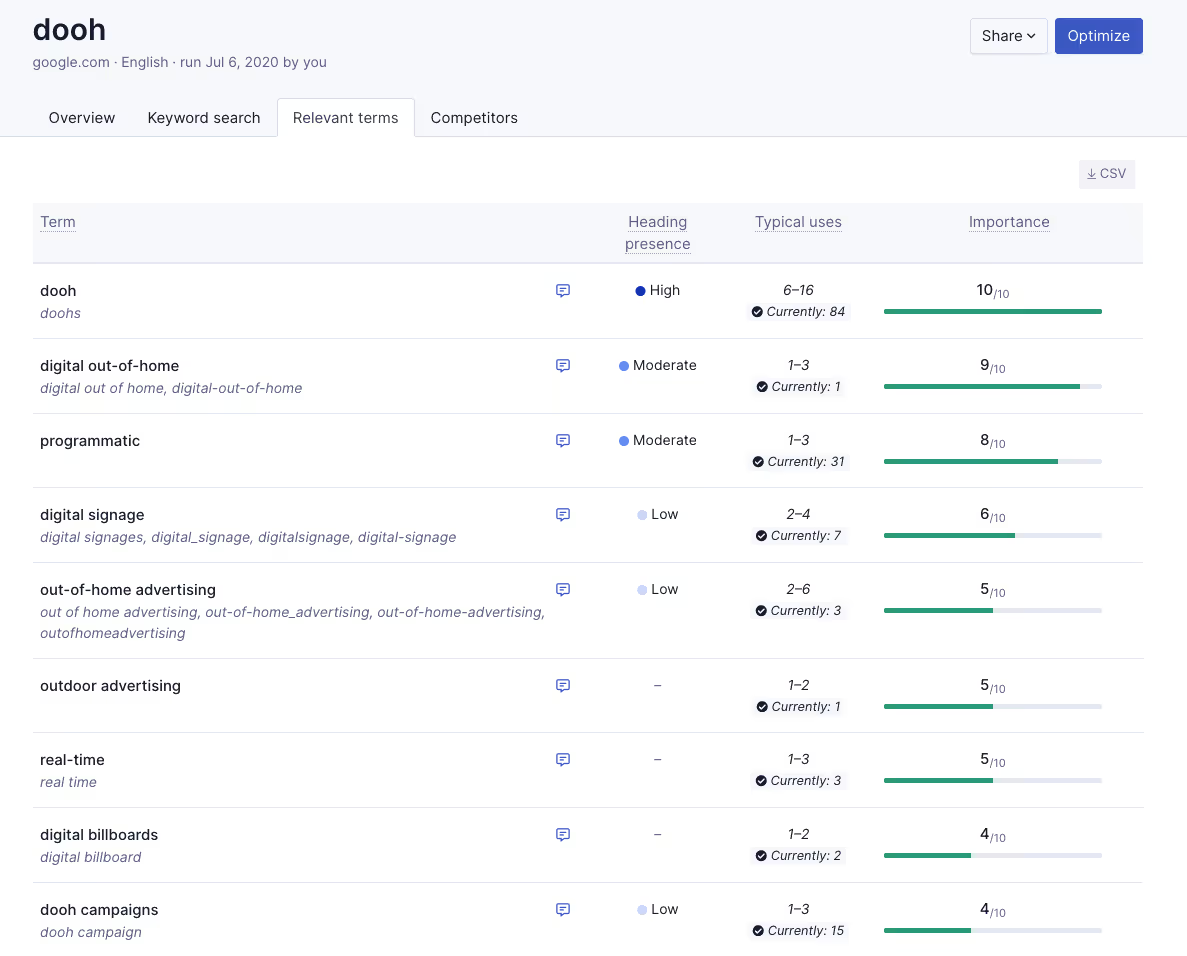
Avoid stuffing these terms without context, as you’ll ruin the content experience and undermine trust. Use this data to inform sections and themes to include in your content.
Finally, don’t worry about perfecting the subheading copy. Subheadings should simply communicate what each section will cover. Once you’re writing the draft, your subheadings should communicate the benefits or outcome that each section promises to deliver. This grabs the attention of skimmers and communicates the overall value of your content.
Outline collaboration
Everyone has their own method of writing outlines. Instead of providing you with a rigid framework, here’s a scrappy example using the DOOH topic introduced above:
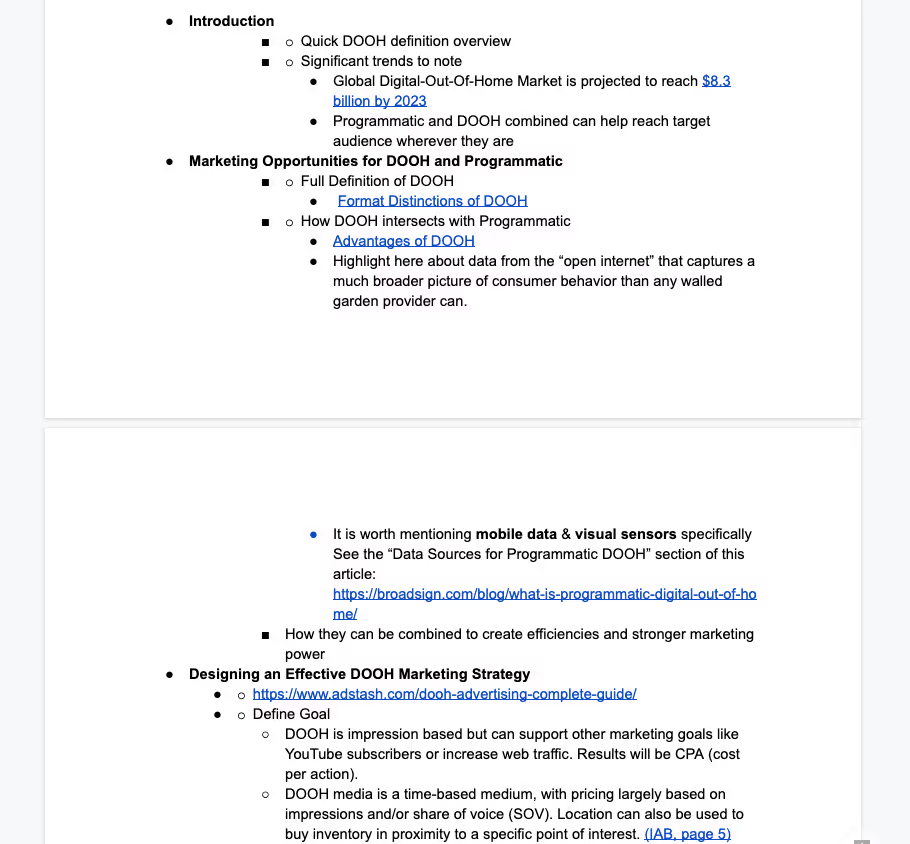
Here, we see a portion of the outline that includes details to add context around what each section will include:
- Outcomes that the target audience will benefit from using DOOH
- Statistics and data to back up certain claims
- Key DOOH metrics to measure, what they mean, and why they’re important
Your outline also provides a canvas for stakeholders to get involved. Including lots of white space and nested bullets will create a hierarchy that’s easy for everyone to follow. Stakeholders can add comments with their thoughts and insights with ease.
Collaborating on an outline will mean fewer draft revisions as the narrative and structure was agreed upon well in advance.
Content briefs are your roadmap
Many marketers see the brief as a hurdle to overcome between having an idea and writing it down.
Your content brief is the compass and your outline is the roadmap. Both allow you to find a gap in the content landscape and uncover an angle that your audience is hungry for and will stand out.
Point in the direction you want to go in, chart a course, and pave the way for content that resonates with your audience.


When making SEO a priority, it can be easy to measure up against competitors. As a result, content loses originality. It fails to stand tall and shine in a sea of content playing by the same rules.
Great SEO-driven content should accomplish the following:
- Alleviate the challenges and deliver specific solutions to make your audience happy,
- Deliver value that answers every single question they have, and
- Make Google happy from a data-driven perspective
In this article, we’ll outline the content marketing & SEO methodology we use to help companies get results like this:
- Fintech company: 25% month-on-month increase in search traffic (~10,000 visitors to ~32,000 in 6 months)
- SaaS company: An extra 10,000 organic visitors a month
- Consulting company: 1,185% increase in search traffic in 12 months
🤫 We’ve included anonymized data throughout this article. Want to learn more about what goes on behind the scenes? Get in touch.
A content research methodology to optimize success
Research is what will make or break your content marketing efforts. It’s a delicate balancing act. In order to capture visibility in the SERPs, your content must:
- Target keywords relevant to your audience & brand
- Satisfy the Google monster, and
- Delight your audience, empower them and give them answers
As well as a data-driven approach, your research must also be qualitative. At the very least, your process should uncover the following:
- An understanding of current trends
- Analysis of content competitors and their high-performing articles
- Customer interviews to generate insights
- Need identification (challenges, pain-points, desires, etc.)
- Keyword research
- Funnel mapping (how the content serves the audience)
- Topic ideation
Content competitors are the brands or publications that are attracting the same audience as you. They may not sell competing products, but they are fighting for the attention of your customers.
It’s also one of our favorite places to start with data-driven research. With the right approach (and tools), you can identify upcoming market trends, common audience challenges and uncover keywords you may not have thought of.
But the most important part of content research is understanding your customers.
This means getting on the phone and conducting customer interviews. If there’s friction, start with your sales or customer support teams. They talk to your customers on a daily basis and hear the same questions, objections and pain points regularly.
The insight and data you collect through these approaches is your ideation fuel. Use it to prioritize topics, set content objectives and map them to the funnel.
Funnels, flywheels and spaghetti hoops – the trusty marketing funnel is under scrutiny in today’s marketing landscape. However, funnels are still a useful tool to help you give your audience the information they need, when they need it.
They control the customer journey. But you can still give them the stepping stones that help them navigate it. That’s what a marketing funnel should do.
Some topics may not have a large search demand, and that’s ok. Your content strategy should be fueled by satisfying market needs, not by search data alone.
A process for comprehensive & original content
Once you’ve prioritized your topics, it’s time to plan and produce your content. At Grizzle, we do this using a “Content Framework”, which covers the objective of the content, search data, target audience information and an outline.
In order to create content that ticks all the boxes, we use a planning methodology that defines the high-level strategy of an article as well as the nuances and details it should contain. A macro/micro approach.
Let’s say we’re creating an article on “transcendental meditation”, with the objective to rank for that keyword. As SEO is the main goal here, the macro-level planning would include an opportunity analysis. This should include the following:
- Content Competition: How comprehensive is the existing content? Does it include proprietary assets we don’t have access to? What are the gaps we can fill?
- Backlink Competition: How many referring domains does each piece of competing content have? Is the competition moderate or fierce?
- Content Opportunities: What do we need to do in order to overcome the competition, and create the most valuable piece of content available for our audience.
On a micro-level, consider sub-topics that would make the content original. For example, can you add unique stories, original insights or influencer quotes? There are dozens of ways to inject originality into your content.
Use this same philosophy throughout the content production process. Start by identifying “expansion threads” – areas of your content that can be expanded upon with more granular insights, advice and how-to information. “Value bombs”, as we sometimes like to call them.
To summarize: Macro/micro mapping means taking a high-level approach to what your content must look like in order to succeed, as well as the details that will ultimately make it original.
A data-driven editorial processes
I won’t wax lyrical about the need for polished, high-quality content here. You already know that a solid editorial process is key for a strong content strategy.
Instead, let’s focus on how we use data to help the process. Using data-driven tools and a general understanding of our audience, we’re more likely to create the best content possible.
Clearscope is invaluable for this process. It helps us identify common themes and weave a logical narrative. For example, here are some relevant terms for the keyword “smart casual:”

Of course, common sense is required. You can’t simply shoehorn a phrase into your content just to tick a box. Look for how to add an original spin on important terms, and use them as a guide when planning content from a macro/micro perspective.
An 80/20 approach to promotion
When publishing content, many marketers go on a promotion spree, spamming every channel they feel is relevant.
However, for pure-play SEO, you don’t need to go nuts. Select a handful of channels where your audience is active, and promote your content there in a contextual manner.
Why? Because if you did your homework correctly, your content should do the heavy lifting. A handful of promotion channels will help get your content on Google’s radar. As a bonus, it’s likely you’ll attract targeted eyeballs in the first seven days of publishing.
[[component]]
However, for SEO-driven content that relies on a reliable publishing schedule, focus on content quality.
What about link building?
In short: Link building isn’t always necessary. For example, we managed to get this Sales Hacker article ranked #1 without any link building, appearing above the likes of HubSpot for our target keyword:
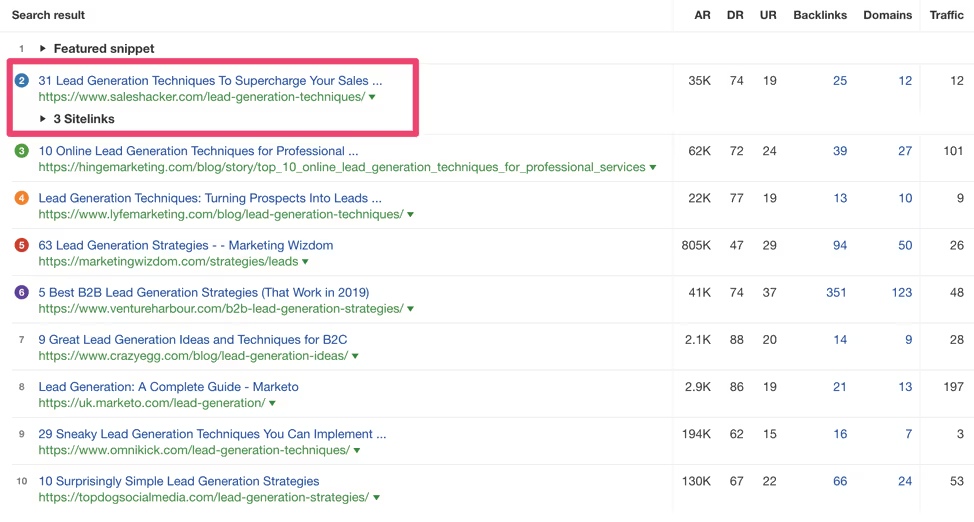
And it’s not an isolated occasion. We recently helped a fintech client rank on page one for a term with over 400,000 monthly searches and a keyword difficulty of 57/100 (according to Ahrefs).
How? Because we committed to creating something 10 times better than the competition. Pick your link building battles and focus on the topics and keywords that need it most.
Conclusion
Getting better SEO results requires the best content. But before you can do that, you need to identify the right topics.
This means understanding your audience’s challenges and needs at all stages of the funnel. Use the funnel as a guide to deliver the right content at the right time.
Ultimately, focus on creating content that delivers long-term nurturing opportunities, while simultaneously catering to visitors who are ready to buy.


B2B marketers must make their account-based content programs relevant. The best way to do this is to become disciplined with customer conversations..
Here, we’ll share an account-based content playbook that accelerates enterprise sales pipeline. You’ll learn how to attract the c-suite, sell to entire buying committees, and cross-sell into new markets through customer expansion.
Converting customer success into content
“Where do you go for new information?” is a common question we ask in our customer interviews.
After countless conversations with senior decision-makers in dozens of industries, we’ve found that most leaders look to their network.
Specifically, they rely on:
- Their direct reports: Both individual contributors (ICs) and middle-management
- Their peers: Commonly those with the same job role in other organizations
This is why customer success content works so well.
It elevates peer experiences and places them in front of your ICP. Goodwill is created within target accounts while proving you can get results.
The approach is even more effective when applied to customer expansion. Not only have you proven your success within an organization, but you’ve already overcome the red tape to become an approved vendor.
But doing this right means making your customer the hero of the story. Here’s how:
Write about shared pain points
Pain points are rarely unique to the individual, no matter what many may think. However, this belief is often a good indicator of problems that buyers are desperate to overcome.
By conducting customer interviews, you can identify these pain points and start to uncover patterns.
Prepare for interviews with account stakeholders and c-suite execs by limiting yourself to a set of broad questions. This allows you to follow “conversational threads,” using follow-up questions to dig deeper into their responses.
For example, the question "what are your revenue goals for the next six months?" may be met with the following response:
“We're looking to develop new revenue streams to improve customer value and improve the product experience to reduce churn.”
This response gives us two conversational threads to follow: “new revenue streams” and “product experience optimization.” But we don’t yet have context as to why and how they’re doing these things.
We can elicit this context using questions like:
- What do these new revenue streams look like?
- Why is improving the product experience important?
- What are the biggest hurdles you face when improving the product?
The answer to these questions may seem obvious, but they allow you to uncover the language customers use and identify new conversational threads to go deeper. It helps you reveal more context, the motivations behind their goals, and the root cause behind the pain point.
Let’s say you’re targeting VP-level marketers working at enterprise software companies. A common problem associated with improving the product experience might be:
“We want to ensure customers are getting as much value from our product as soon as possible. ‘Time to value’ is an important metric to us because we want to drive adoption across all teams within customer accounts.”
We now know the following:
- “Time to value” is an important metric
- This means customers get as much value as quickly as possible from the product
- Why is it important? Because it’s correlated with greater account value as more users adopt the product
Individual contributors have their finger on the pulse of these challenges. Make time to speak with both senior decision-makers and ICs to understand how a problem impacts the entire organization.
Cater to the buying committee
The sales cycle is more than a series of calls and consultations. It may start that way during discovery—where one or two stakeholders lead the conversation—but behind the scenes you have their bosses, CFOs, and procurement teams to convince.
Trouble is, you don’t have direct access to these people, and therefore cannot directly influence their decisions.
Account-based content helps overcome this bureaucratic maze. It acknowledges that the needs of stakeholders beyondt your immediate buyer must be catered to.
What content should you create for buying committees? Start with the following ideation process:
- Customer interviews: Again, ask questions about what the buying and procurement process looks like for your customers.
- Sales teams: Work with sales leaders to collect insights. Arm your reps with the right questions and communicate how it fuels material that will help them close more deals.
- CRM data: Segment your best accounts and review contact history. Which contacts were involved early on in the sales process? Are there any insights that can be gleaned from sales activity and notes left by reps?
Turn these insights into decks, short-form articles, slides, and even video content. Tools like Loxo allow you to create microsites for each account, organizing content in a personalized manner that makes it easy for your prospect champions to get internal buy-in.
Empower individual contributors to influence upwards
Alongside peer recommendations, senior decision-makers look to their direct reports for insights from “the field.” These include new ways of working, vendors, and content that aligns with internal conversations.
Top-of-funnel content still has a place at the table. ICs and middle-managers help senior decision-makers filter through the noise and have bottom-up influence in an organization.
Here’s how to write for ICs:
- Position content around daily tasks and priorities: While ICs rarely have buying power, they are your end user. Providing actionable content around specific use cases will arm them with a solution to present to their managers.
- Integrate organization-wide challenges: Some problems run so deep they frustrate entire teams. Write about these to create internal buzz.
- Focus on the big problem early on: Don’t keep strategic pain points hidden halfway through an article. Use article and section introductions to make it clear your audience is in the right place.
When writing for ICs, make them think “I need this, and so does my boss.” Teaching them how to solve a JTBD can act as a trojan horse.
For example, message testing platform Wynter’s ICP is VP-level demand generation and product marketing leaders, but this article on message testing caters to a beginner audience:
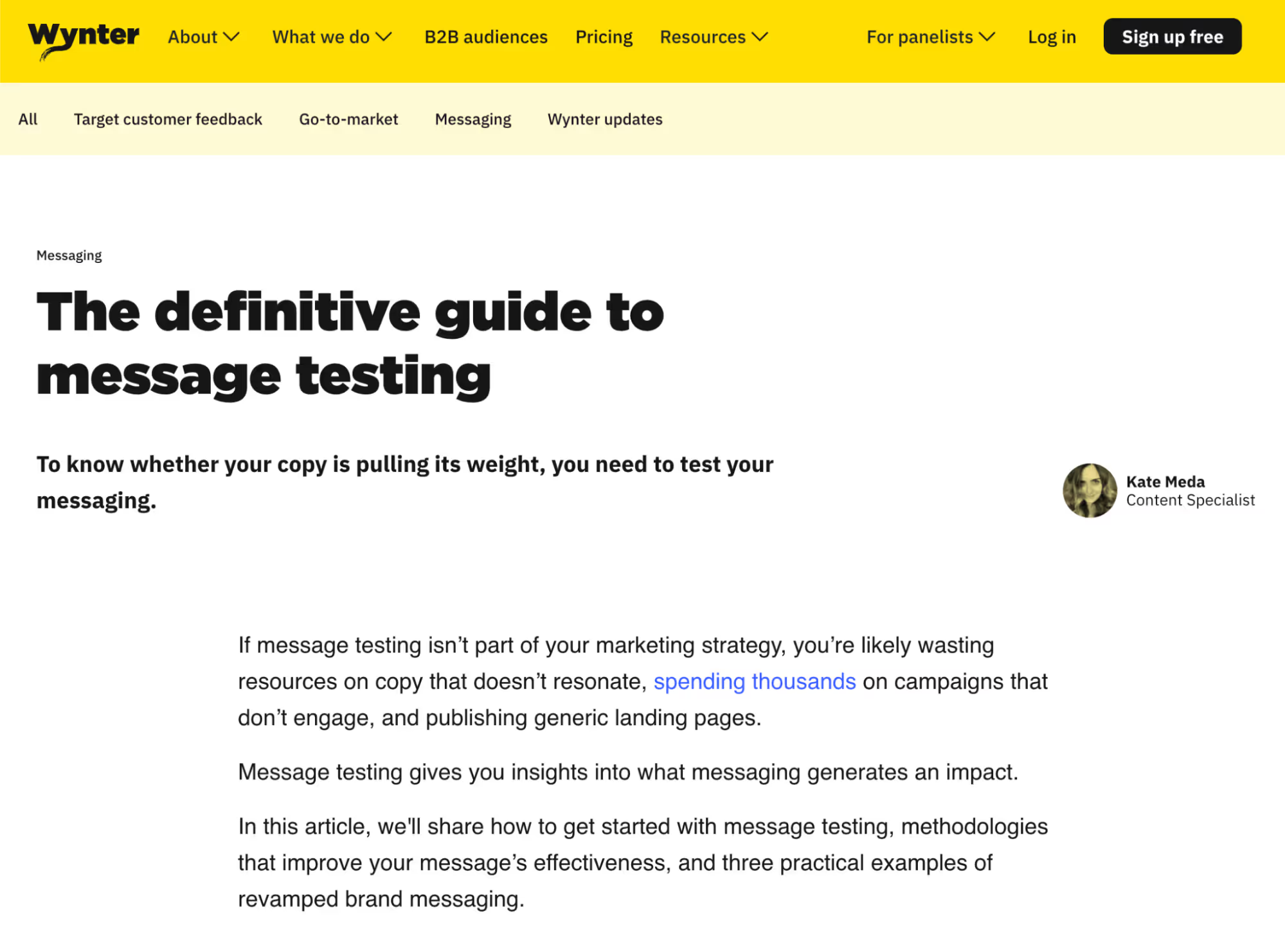
It ranks for the primary target keyword because it caters to a beginner audience. ICs are looking for information on the topic because they want to learn what it is, how to do it, and examples of it in action. The same goes for VP-level audiences who have yet to discover what message testing is.
Creating content for both buying committees and ICs alike gives you a diversified content portfolio. In the account-based marketing world, it pays to cater to all seniorities.
Create episodic content
Episodic content applies various topic ideas and formats around a central theme.
In a recent episode of the Demandist podcast, Nitsan Peled, Director of Content at Optimove, shares how he takes an episodic approach to account-based content:
“We took from Netflix’s book. So if [for example] we want to talk about segmentation, we come up with a series with a title or topic. And then we break it down into chapters. And we find someone to write those chapters.
“We come up with seven episodes. [Each] episode would be dedicated to a specific brand.”
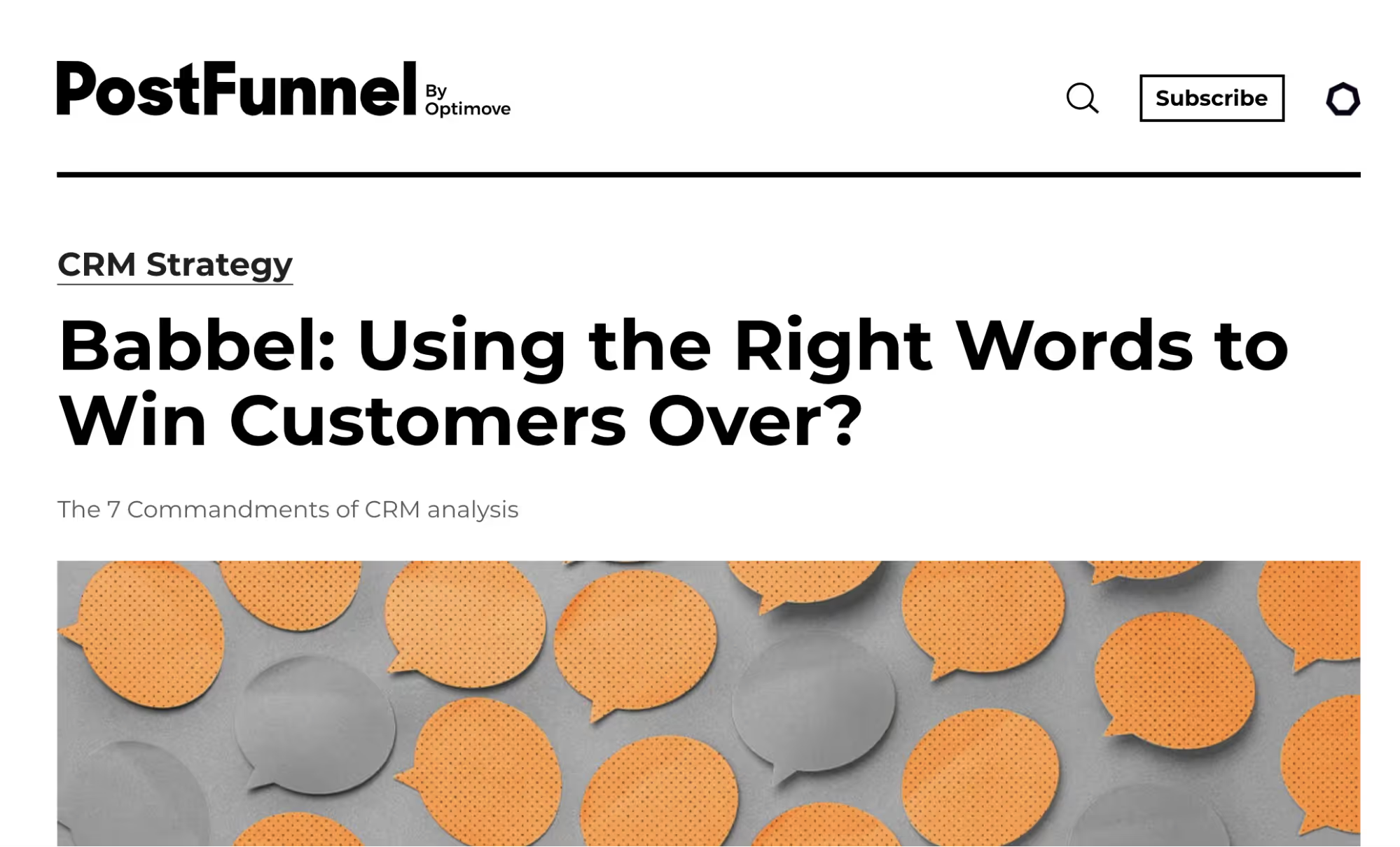
This approach allows you to:
- Demonstrate you understand the world your customer operates (think subject matter expertise and industry challenges)
- Share the success you’ve already delivered to customers and other departments within existing accounts (for your customer expansion efforts)
- Provide actionable insights and guidance for ICs across an organization
Dedicating a content series to a single industry, job role, or JTBD can seem like a mammoth task. However, the concentrated attention it yields can have a compounding effect on pipeline and awareness—especially when attracting a narrow audience.
Account-based content distribution
Getting your content seen by target accounts requires a personalized approach to distribution.
To capture your ICP’s attention, you must go beyond traditional promotion tactics like content repurposing and email newsletters.
1. Empower your existing customers
Your customers are your biggest advocates. Getting them involved in the entire content production process not only highlights success, but primes them to share it.
They’ll also give you insights into how other areas of the business operate, which is crucial for customer expansion.
Once you’ve injected customer stories into your content (as well as any direct quotes from users), give them the tools they need to amplify it. Provide them with guidance and ease objections with a plan that they’re comfortable with.
Here’s how your customers can help with distribution activity:
- Repurpose for social: Make the sharing process easier for them by writing LinkedIn posts on their behalf. Get them on a call, ask them a question about the topic, and then repurpose the recording into short-form video content.
- Reach out to internal influencers: Identify contacts within existing accounts. Gauge whether it’s appropriate to reach out and share that content directly.
- Share on internal channels: There may be an employee forum or community where cross-department conversations take place. Uncover this during the early stages of the process, and only suggest it if your customer feels it’s appropriate.
For customer expansion efforts, you must also uncover:
- The cultural barriers you must overcome
- How buying committees work in different geos
- Whether or not they share the same pain points
The world is getting smaller from a communications perspective, and many of these factors may no longer apply (especially when marketing to millennials). However, do your due diligence to ensure your messaging is appropriate.
2. Create an employee advocacy system
Speak to your salespeople and identify target account contacts they’re engaged with. Involve reps during the earlier stages of the production process. Encourage them to participate during the topic ideation stage.
Uncover the objections they experienced when closing customer accounts. Use this to fuel social content that acts as an idea barometer. The more engagement a post gets, the more likely it is that a long-form article will perform well.
Coordinate with reps and keep them up to date with your publishing schedules. Encourage them to share your content directly with their prospects and amplify it on channels like LinkedIn.
3. Repurpose for social
Double-down on your employee advocacy and customer success efforts by creating a series of social posts for your company page.
Yes, we all know personal profiles (anecdotally) generate more engagement than company pages. But this is only true because brands don’t push the envelope and give their brand a personality worth following.
Just look at Lavender as an example, which has amassed over 26,000 followers in a matter of months due to their fun and educational content:
To extend your reach and get the attention of other account employees, tag them in your post. But only do this if they’re involved in the content itself.
Repurpose your how-to articles into a series of posts that dive into specific elements. Highlight relevant pain points and dig deep into specific challenges. Don’t forget to cater to both senior decision-makers and ICs.
4. Guest case studies
Repurposing your success stories into guest posts can quickly get your message in front of a wider audience.
It’s also a great incentive for getting customers involved. Speak to several contacts to learn which publications they read and which are most popular.
Secure placements by reaching out to editors and pitching topics that sit in the sweet spot of these three areas:
- What the publication is hungry for: Look at recently published articles. Reverse engineer the highest performers (think social shares) to find top performing formats.
- Conversations happening in the market: Tie your customer success stories to pain points experienced by the rest of the market.
- The problem your product solves: Focus on a relevant pain point that a specific product feature solves.
Checking all three boxes ensures your guest post will get accepted. Have your cake and eat it too by writing about themes close to your product and ICP challenges.
Land and expand
Individual contributors, junior executives, and director-level leaders are all working towards the same goal.
Your content should serve everyone involved in achieving it. Make your account-based content work harder for you by writing for everyone with skin in the game.
You can’t always do this with a single piece of content without diluting your message. However, with a well-coordinated plan of attack, you can work all ends of the chain and get the entire department’s attention.
Establish authority and expand your customer accounts by getting the whole team talking about you.


In this in-depth guide, you’ll learn the process we use to help brands like Pipedrive and Tide improve content quality, boost search visibility, and drive more user sign-ups.
Content maintenance: Detecting decay and improving conversions
Content maintenance is the process of monitoring your content and improving it based on leading metrics. This could mean adding new sections, editing and expanding on existing content, making technical tweaks like adding internal links, or testing new calls-to-action.
Why is this an important part of any organic growth program? Over time, a blog post will hit a peak of traffic. It will then typically lose traffic (slowly or dramatically) as it becomes outdated or competitors enter the fray with more up-to-date information.
This is especially true in fast-moving industries like social media or finance. Here, we see that a particular article quickly ranked for a highly competitive keyword in the social media space:
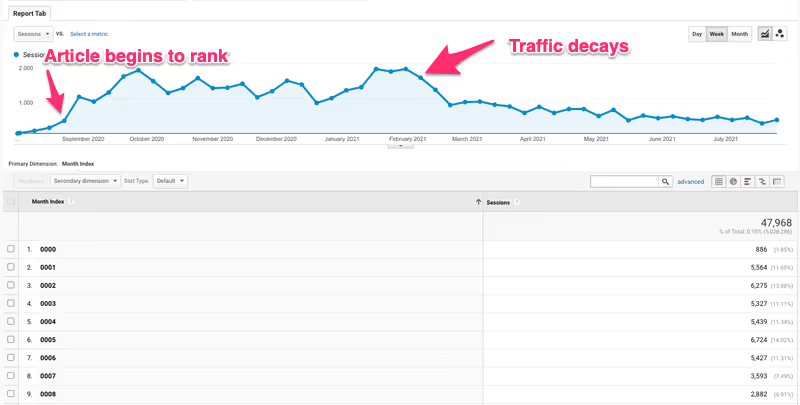
Due to the nature of the industry, other players create better content or update their existing guides to be more relevant. Slowly but surely, the article above was knocked from the top spot in Google.
Now imagine how this happens across an entire blog featuring hundreds of articles. Decay can add up to the tune of losing hundreds of thousands of unique monthly visitors.
So, how do we fix this problem?
Are you buying a car or investing in real estate?
Your blog acts as a portfolio of content and other digital assets. Much like brick-and-mortar investments become dilapidated through neglect, so does traffic and conversions that SEO-driven content generates.
Similarly, treat that same piece of content with care and respect, and you’ll see its value soar.
Content optimization systems don’t just protect you from traffic decay. They help you identify issues before they happen and take proactive steps to fix them. Similarly, they help you identify new and lucrative SEO opportunities.
For example, we helped a martech brand develop an aggressive SEO-driven content strategy to rank for highly competitive keywords in the paid media space.
Our goal was to solve their audience’s specific pain-points to demonstrate they’re the best solution for them while generating relevant search traffic.
One particular project was a “wiki” style guide, providing advanced information that provided readers with huge amounts of value.
We quickly captured the #1 spot in Google for our primary keyword, but over time ranked for the parent term. This presented an opportunity to increase traffic without creating a new piece of content.
We ran the article through our content optimization and refresh process and, in just 30 days, we increased search traffic to this single article by 301%:

The two processes that made this possible are:
- Content audits to measure the right metrics in a proactive way
- A content refresh and optimization process that puts data and audience needs first
Most marketers run quarterly or annual content audits. By the time problems or opportunities are identified, the competition already has a leg up. The longer you leave it, the harder it is to fix issues and capture new opportunities.
Instead, consider auditing your content weekly or monthly depending on the size of your content portfolio (i.e. the number of blog articles, landing pages etc. you have).
Similarly, a content refresh is more than simply adding the right phrases and terms to make content more relevant. It must fill newly identified gaps and overdeliver on value in a way that nobody else can.
To overcome these challenges, we developed the following content optimization process:
- Collect the right data
- Use a content audit tool to wrangle data and identify issues and opportunities
- Prioritize content optimization projects based on a) severity of issues or b) how lucrative each opportunity is
- Optimize each stage of the content journey (from SERPs to introduction to call-to-action)
- Track and monitor changes to pivot where necessary
The rest of this guide will cover these steps in detail.
1. Identify issues and opportunities with a content audit
The first step is to identify, wrangle, and benchmark the right data to identify issues and new organic growth opportunities.
A content audit that measures the entire content journey is key, which looks something like this:

Here’s how to build a content audit tool step-by-step:
Collecting content performance data
Collecting content performance data only requires a handful of tools:
- Ahrefs/Semrush
- Google Analytics
- Google Search Console
- ScreamingFrog
- HotJar
Metrics are selected based on the reports needed to monitor each stage of the journey. For example, at Grizzle, we’d use data from a tool like Semrush to collect the following KPIs:
- Organic keywords that are being ranked across the entire site
- Specific keywords we’ve developed our content around
- Distribution and backlink performance
Similarly, you need engagement data, organic performance across each article, and conversions from Google Analytics.
Each of these data sources have their own sheet in the content audit, which looks like this:

Monitoring each stage of the content journey
Every interaction across that content journey can be measured. These interactions each play a part in the overall performance of your content.
Bring these metrics into a single view or sheet in this case to get a high-level overview of how content is performing across the entire journey. We call this the “Content Analysis” view, and is broken down by the following content journey stages:
SERP Performance
- Clicks
- Impressions
- CTR
- Avg. position
SEO Performance
- Top Keyword
- Volume
- Keyword Difficulty
- Current Position
- Internal Links
Content Performance
- Pageviews
- Avg. Time on Page
- Bounce Rate
- Conversions
- CR%
Distribution
- Organic Traffic
- Referring Domains
- URL Rating
- Dofollow
- Nofollow
Digging into SERP performance, you can see a “red amber green” (RAG) system under the CTR column:

- Green means we’re hitting an adequate CTR from the SERPs. A healthy number of people are clicking through to our content when they search for something in Google.
- Yellow means things are “ok”, while red is a problem. As you can see, anything below a 1% CTR is cause for concern.
For SERP performance, CTR is our leading performance indicator. For SEO performance, there are two:

- Current position: Where content ranks for your “top keyword”?
- Internal links: How many internal links are pointing to this content from across the site
Note that “top keyword” is different to “primary target keyword:”
- Primary target keyword is what an article was originally written to rank for
- Top keyword is the keyword that the article ranks for with the highest search volume (no matter what position it’s in)
For example, in the report above, you can see that the top keyword for the first row is “net profit,” which has a search volume of 7,600. However, the primary keyword is “net profit margin”, which generates 2,600 searches a month.
Our content ranks for both, but the “top keyword” is not one we deliberately aimed to capture. We can use this insight to optimize content for broader keywords, increase search visibility, and capture more organic traffic.
This content audit may look overwhelming. For us, it started as a series of IF statements, VLOOKUPs, and conditional formatting. Start here and build out more sophisticated reporting as your systems evolve.
Once you’re monitoring opportunities and issues, it’s time to start fixing them.
2. Increase CTR and SERP performance
Why do people click on one search result over another?
Usually, it’s because the metadata aligns with what they’re searching for and communicates the benefits of the content.
This means your best bet of increasing CTR is optimizing page titles and meta descriptions.
Let’s start with page titles. When you search for a keyword, you’re often met with a series of results that look awfully similar:
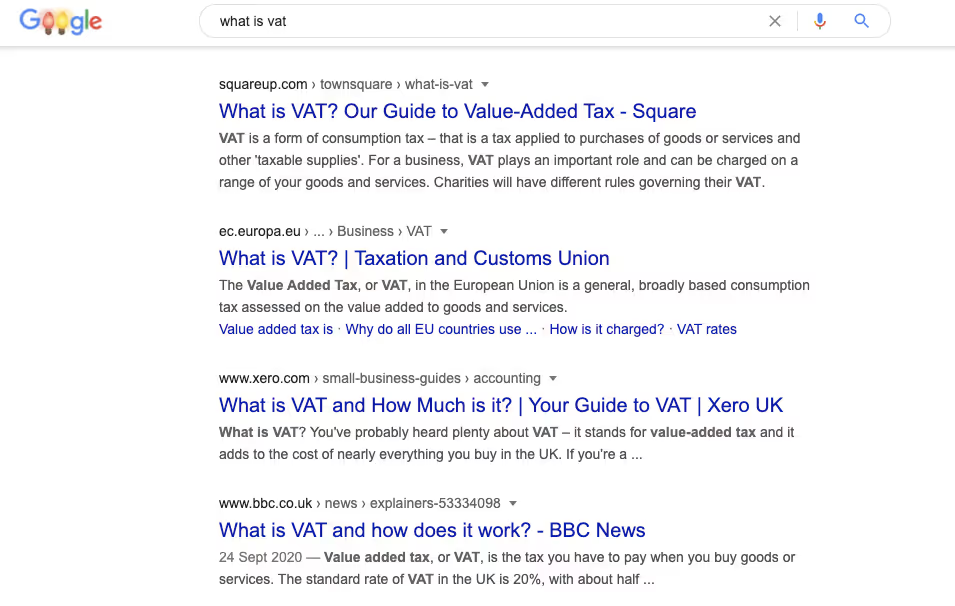
Luckily, Google has done a lot of the heavy lifting for us. These are the results that it deems most relevant based on user behavior. In other words, when a user clicks a result, it sends a signal to Google that their attention was captured when searching for a specific query.
The more people do that on a particular result, the more Google deems that page the most relevant result, and thus, it ranks higher.
While this is an important signal, most marketers use the SERPs as their single source of truth when researching elements of their content. They’ll simply emulate whatever they see on page one of Google and make a few subtle tweaks.
When writing page titles, a better approach is to emulate what Google is serving while using the language of your audience. This will not only let your content stand out, but show users that you understand their needs.
There are a handful of ways to do this:
- Speak to your customers and ask them questions related to the topic
- Ask questions in relevant communities
- Use audience intelligence and social listening tools
For example, following on from the “what is VAT” search in our screenshot above, we find the following relevant posts in Quora:
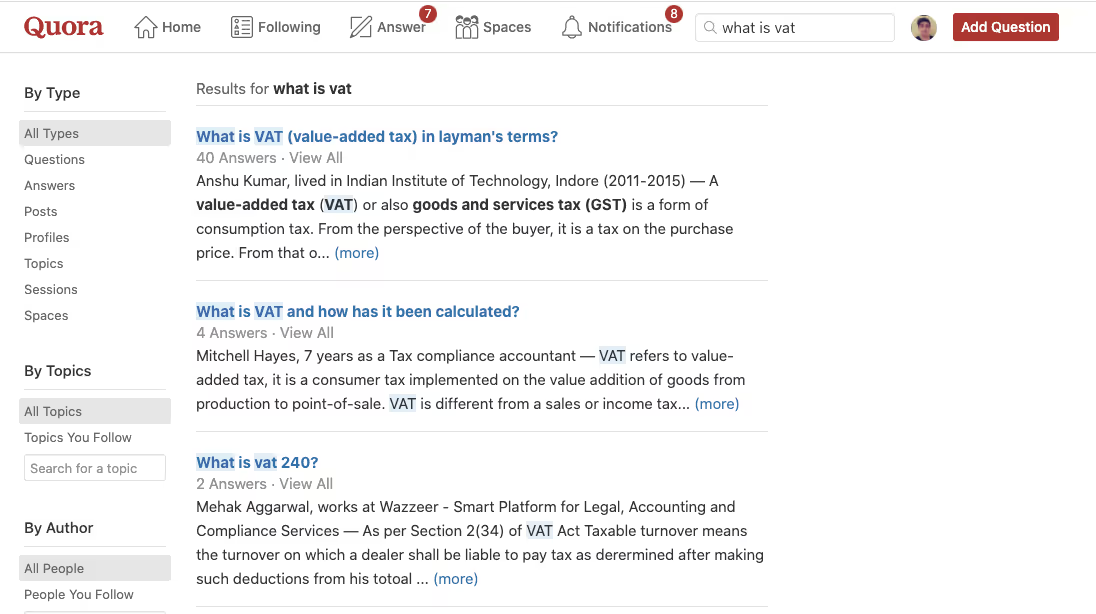
The most popular post asks for a definition in layman’s terms. Further research shows that our audience wants an easy-to-understand definition of what VAT is.
We can then take the language of this audience and use it in our page title:
“What is VAT? A Layman’s Guide to Value-Added Tax”
The same approach can be applied to the meta description:
“In this complete guide to VAT, you’ll learn how to calculate value-added tax and what it means for your business (current rate: 20%).”
Based on our topical research, we determined that the following elements are important to our audience and should be included in the article:
- A complete guide to VAT with everything they need to know
- How to calculate it
- Why it matters to their business in the first place
- What the current VAT rate is
We made sure our page title and meta description communicated these elements, first making sure that our content delivers on those promises.
Some of the pages on the SERPs do this, but few (if any) do all of them. This page title and description successfully ticks three boxes:
- We’re working to fulfill existing search intent
- We’re differentiating our content among a sea of “sameness”
- We’re talking the language of our audience
3. Improve internal linking across your content
Proper internal linking can have a huge impact on search engine rankings. For example, Ninja Outreach managed to increase organic traffic by 40% through a robust internal linking project:
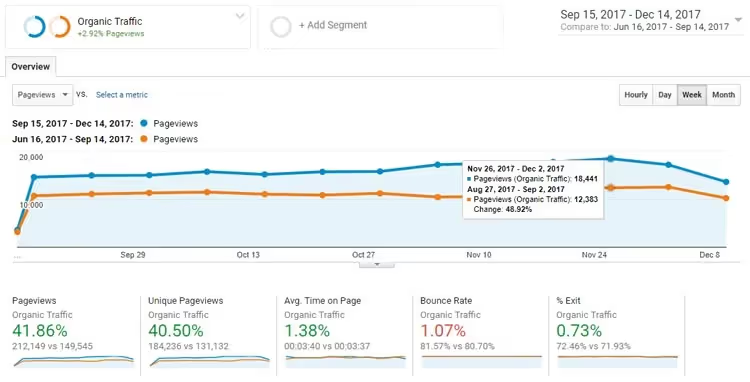
To find internal linking opportunities, simply group together pages of the same topic cluster and order them by page authority (PA) or URL rating (UR). Then, add internal links from relevant pages to the content you’re looking to optimize.
Alternatively, you can use the “Top pages” or “Best by links” reports in Ahrefs:

4. Refresh your content for higher search rankings
Content refreshing is the most powerful optimization tool at our disposal. Done right, you can see an increase in search rankings and conversions just by improving the quality, relevancy, and depth of your content.
There are over a dozen techniques we use to optimize and refresh content. However, the levers that make the biggest impact are:
- Using data-driven tools like Clearscope to improve relevancy and inject important themes
- Improving quality, information gain, and offering a unique angle
Clearscope is a foundational tool for making sure content is relevant. It collects data from IBM Watson and Google Graph Map to determine which themes Google deems most important for a primary target keyword.
Research by Backlinko found that “content with a high ‘Content Grade’ (via Clearscope), significantly outperformed content that didn’t cover a topic in-depth:”

But you can’t simply stuff new terms in your content and expect to see improvements. Instead, use these terms as a litmus for what you should include or expand on in your content. Give readers everything they need to understand and act on the advice you’re providing them.
Take the following subsection for an article on “self assessment statements” in UK:
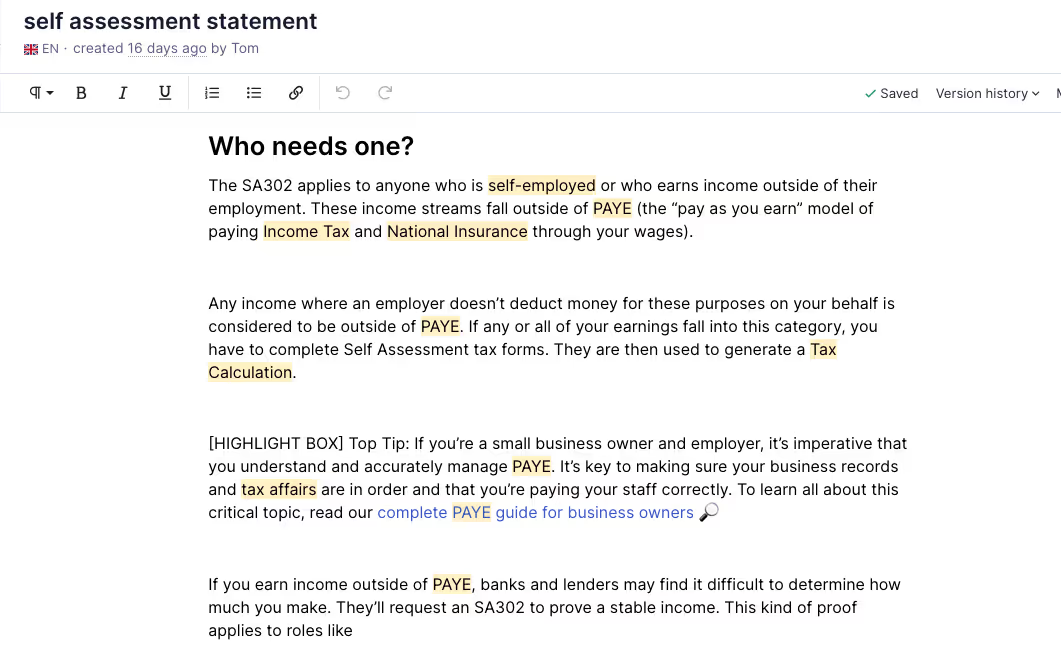
The highlighted text is what Clearscope deems “important” from an SEO perspective. The following appear in the subsection:
- Self-employed
- PAYE
- Income tax
- National insurance
- PAY
- Tax calculation
- Tax affairs
These terms aren’t “stuffed” into the content carelessly. They add context and value, building a detailed narrative and answering the question; “who needs a self assessment statement?”
When using data-driven tools, ask yourself why a term should be added. Does it need its own subsection to allow for a large enough canvas that explores the topic in as much depth as possible?
Don’t forget to expand on threads. These threads include the topics, ideas, and themes that are presented in the content that needs additional depth.
Close the loops started in your threads by including:
- Examples
- Detailed explanations
- Stats and data
- Actionable takeaways
These elements give your readers everything they need to take action. It also makes sure your content is comprehensive, which strengthens your moat and makes it harder for competitors to outperform you.
5. Boost content engagement by keeping your readers hooked
Low avg. time on page, bounce rates, and even low scroll depth (measured using scroll maps) happen when content fails to:
- Quickly hook the reader in
- Keep them engaged and excited throughout the content
- Deliver on enough value to instill a feeling of empowerment
Most people don’t have low attention spans, they have low consideration spans. You only have a few seconds to capture that attention by proving you have what a reader (or searcher) is looking for. Introductions that pique interest or make a bold promise are key. As are value-driven subheadings.
For example, in CXL’s article on app store optimization (ASO), the first section gives a high-level overview of what ASO is and why it’s important:

We could have just written “What is ASO?” Instead, the subheading communicates the specific outcomes that CXL’s audience of seasoned marketers are yearning for.
Once you have their attention, you must keep them hooked. This means communicating in a clear manner while overdelivering on the value you’ve promised.
Filler and fluff is your worst enemy. Every unnecessary word creates friction that prevents your reader from gliding through your content.
For example, here’s a subsection taken from another article from CXL on storytelling:

Let’s break this subsection down paragraph by paragraph:
Focus on shared interests and values. Speak to passions, relatable experiences, common problems, gaps in the market—whatever makes your audience feel connected to the message at a high level.
The first sentence of this subsection provides value in no more than six words. It continues by offering how to build intrigue (passions, experiences) and communicates why it’s important (it makes your audience feel connected).
Wealthsimple does this expertly in their digital magazine. Take this story about avoiding financial troubles under the pretense “It’ll Work Itself Out”:
We're then introduced to an example and supporting imagery of this principle in action. This makes our content easier to digest.
“It Actually Won’t” is a clever one-two punch. Immediately, the reader understands:
* This is a story about debt woes (a relatable problem, given that consumer debt in America reached a record high in 2020)
* Ignoring them will make it worse (debt denial and financial strain can lead to high levels of depressive symptoms)
80% of Wealthsimple’s clients are under 45. Because the familiar story is told by a peer and not a faceless brand, it works to build authority.
Here, a perspective of the example is shared, along with two clever components and an analysis on why they’re effective. We're not leaving the reader to connect the dots themselves, we're doing it for them.
Many readers see themselves in this story. Living paycheck to paycheck, even with a good job, saddled by debt, and paralyzed by calls from debt collectors.
This paragraph brings it back to the topic at hand. At the beginning of the subsection we talk about the importance of shared interests, values, and experiences. The way Wealthsimple does this is by sharing customer stories, which delivers a takeaway from the example.
The story pulls the reader in and incites a desire to learn more. What does this company have to offer me? Have they solved the author’s problems?
The section is then concluded while acting as a “bridge” to the next. We’re left wondering, “what’s next?” The answer is in the next section.
In just 190 words, this section provides the following "aha!" moments:
- The "ingredients" we need to build intrigue (values, experiences, etc.)
- Why those ingredients are important (to make the audience feel connected)
- An example of a brand that does this well (illustrating the lesson)
- A breakdown of why the example works so well (debt and financial strain is the shared experience of their audience)
- An additional outcome of this story (Wealthsimple builds authority)
- How this looks from the eyes of Wealthsimples's audience (they see themselves, trying to overcome debt)
- What I can do with this information (build intrigue to pull readers in and entice them to learn more)
As well as an easy reading experience, you must continuously teach users something new. Provide “aha!” moments as often as possible; either by presenting a new idea or reinforcing those ideas with examples, takeaways, and instructions on executing them.
At Grizzle, we call this “Aha! Velocity.” It’s the speed at which new information is shared or the rate at which readers connect the dots between existing ideas.
Increase your “Aha! Velocity,” make your content easy to read, and you’ll have high-performing content that people will read from start to finish.
6. Optimize conversions by testing new CTAs and offers
There’s no point in creating content that people love if it doesn’t contribute to your acquisition, retention, or demand generation efforts.
Low conversion rates from content usually occurs due to a misalignment between the offer and where in the journey your readers are at.
For example, if a user wants to learn the basics of “digital transformation,” it’s unlikely they’ll be interested in a service that does it for them (yet).
Instead, offer them templates, cheat sheets, and resources to make a case with their bosses. Build and nurture an audience and convert them into customers or users when the time is right.
For example, Pipedrive heavily invests in top-of-funnel content as part of an aggressive SEO strategy:
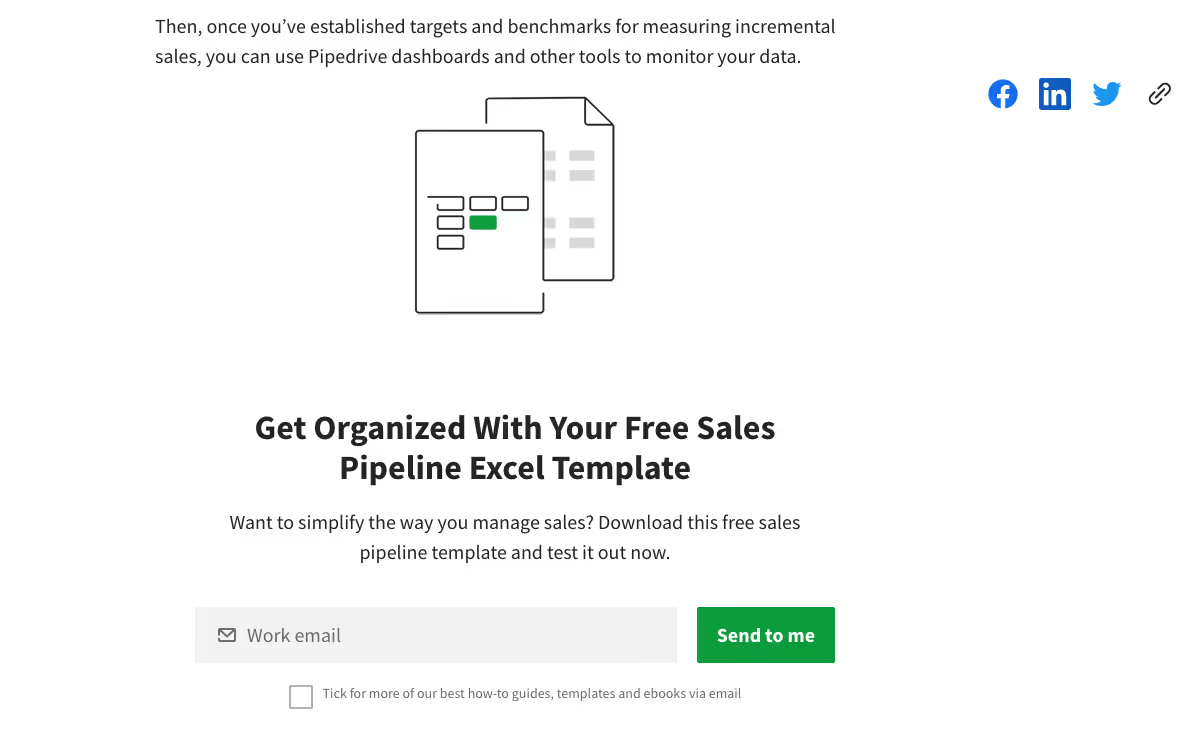
Here, they offer a relevant resource to help readers solve a job-to-be-done (JTBD) presented in the article. Pipedrive could have offered a free trial of their CRM, but understand the value in audience building and serving readers first.
On the flip side, someone looking for an alternative to HubSpot is probably ready to test out a new CRM.
Content should generate ROI. But not at the expense of audience building and brand equity.
Start a relationship with your users. Use your email marketing, social media, and retargeting capabilities to strengthen those connections by nurturing and educating them over time.
Strengthen your content portfolio
For those who have never optimized or refreshed their content, the first step is to conduct an in-depth content audit like the one presented in this guide.
Measure each stage of the content journey to identify issues that need fixing. Improve your CTR, refresh your content to make it more relevant, and you’ll begin to see your organic traffic soar.
[[component]]
